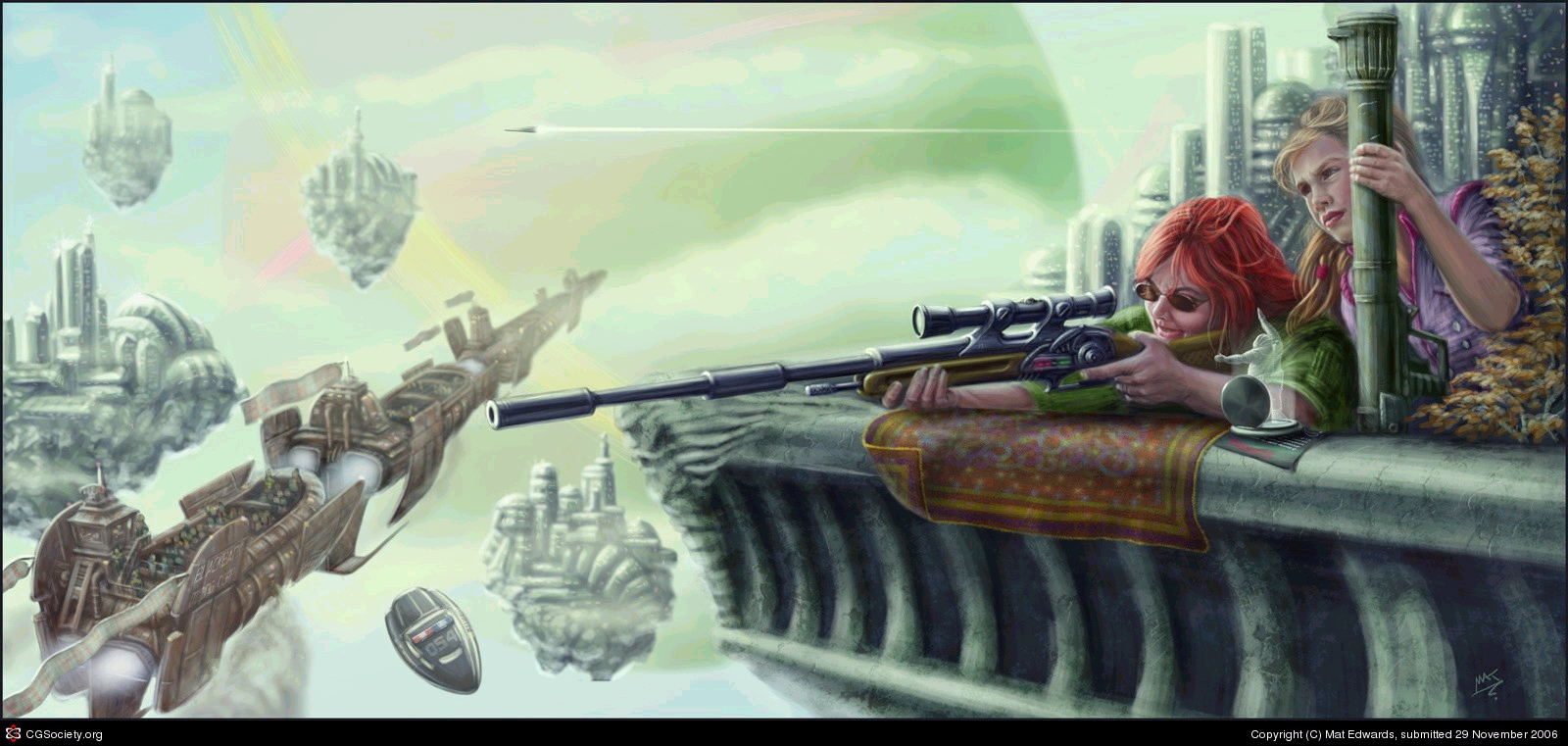UPDATED 28 March 2013
The Great 21st Century Rifle Controversy
At the dawn of the 21st Century, as U.S. troops are engaged in 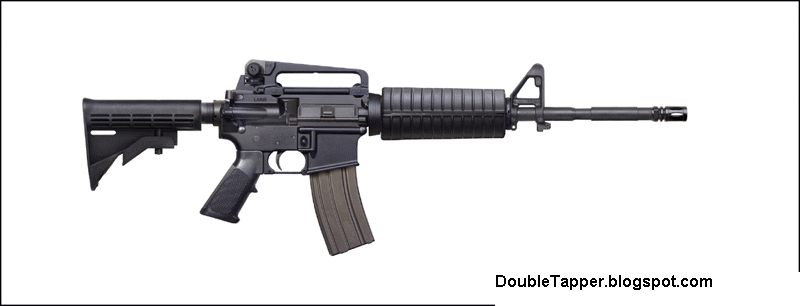
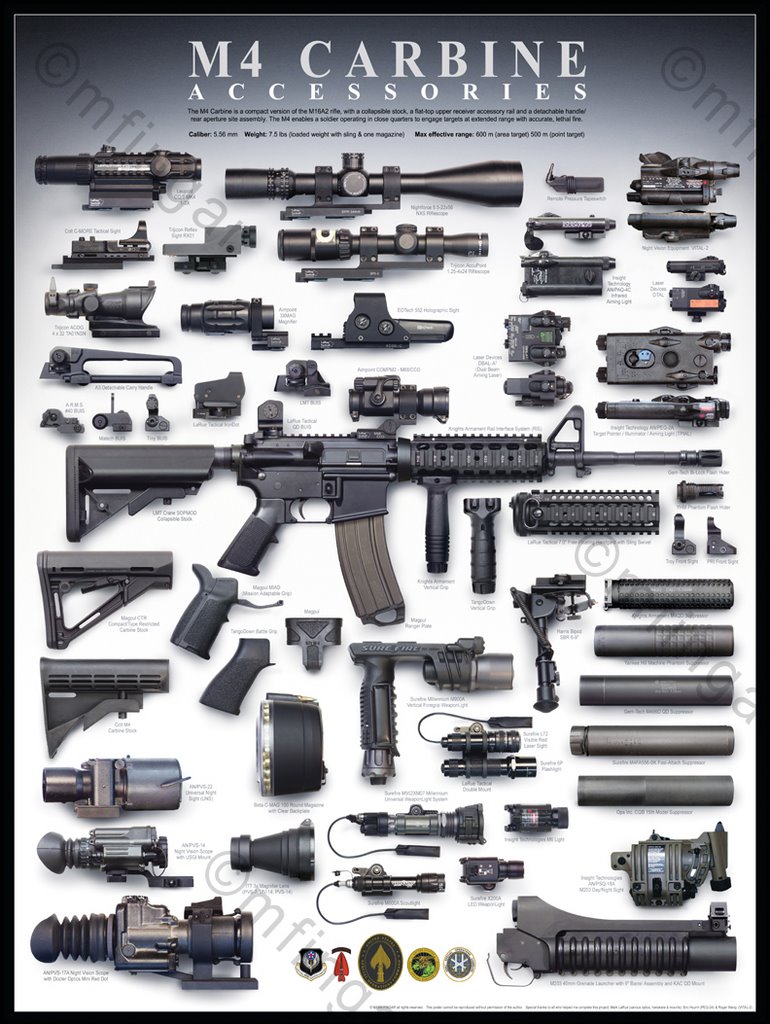
The rifleman is the centerpiece of a nation's freedom because he can defend not only his home but his conscience. In more mature countries like Switzerland, Citizen-Soldiers take their assault rifles home and are ready like America's Minutemen of old. Dictators don't want YOU to have rifles but they love 'em.
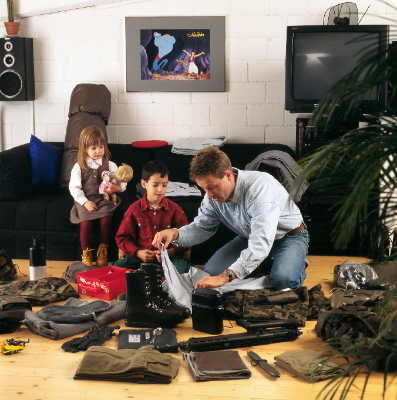
Here's a history of what happens after governments have disarmed their citizens:
1911 - Turkey disarmed it's citizens, and between 1915 - 1917 they murdered 1.5 million Armenians.
1929 - Russia disarmed it's citizens, and between 1929 - 1953 they murdered 20 million Russians.
1935 - China disarmed it's citizens, and between 1948 - 1952 they murdered 20 million Chinese.
1938 - Germany disarmed it's citizens, and between 1939 - 1945 they murdered 6 million Jews.
Presidents and Rifles: A Study of Good Vs. Evil

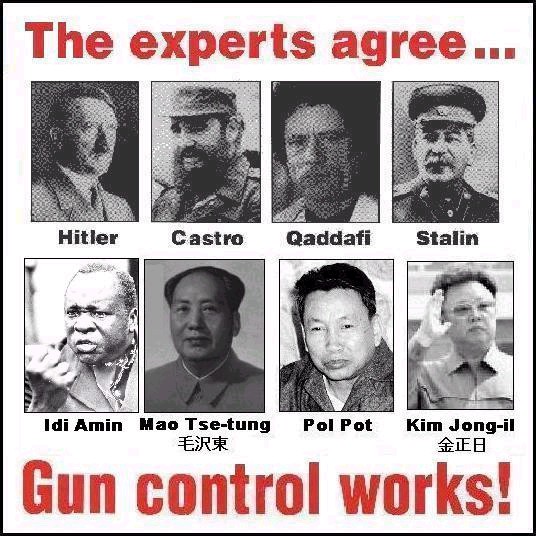
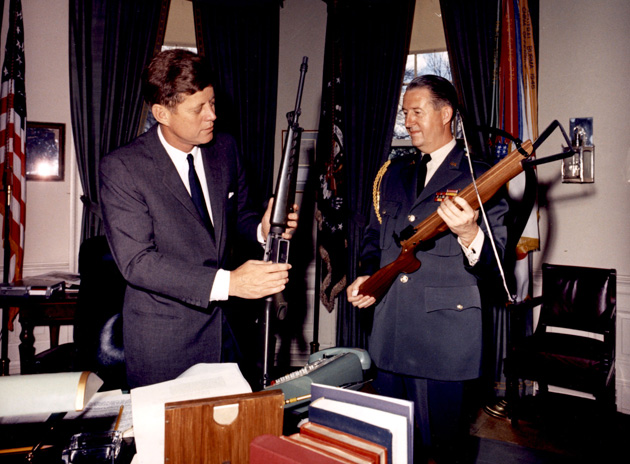
The amazing picture above shows President Kennedy with an early-model, futuristic M16 in 1963. The irony is that in a few months evil men would assassinate him using multiple rifle fire in a "L"-shaped ambush in Dealey plaza in Dallas, Texas because he wasn't pro-war enough.
After WW2's end with many combat veterans aware of the power of aimed rifle fire, assassination by rifle was all the rage within the Nazi-run CIA that exalted in rifle usage in its do-it-yourself (DIY) manuals. Hollywood got into the act with such movies like the 1954 "Suddenly" starring mob-connected Frank Sinatra that have a disturbing similarity to the actual murder of President of the United States (POTUS) John F. Kennedy (JFK). JFK and his brother, Robert F. Kennedy (RFK) sponsored plots to murder Communist Cuban dictator Fidel Castro; one program was named "ZMRIFLE".
Aimed rifle firepower--particularly with fast reloading by manual levers or turn-bolts revolutionized warfare beginning in our Civil War in 1860-1865. POTUS Lincoln saved our nation by innovating like printing debt-free money to fund the war effort and by pressing conservative loser Union military bureaucrats to adopt repeating rifles. When military bureaucrats stood in the way of military excellence, something amazing happened: LEADERS employed DIY.
http://vernon.patch.com/articles/target-shooting-with-abe-lincoln-spencer-repeating-rifles-manchester-roots
Colonel John T. Wilder of Indiana, who was an inventor himself, had personally witnessed a field trial in Tennessee of Spencer's rifle. Wilder obtained a loan from his hometown bank in Indiana to purchase 2,000 Spencer Repeating Rifles. Each man in Wilder's brigade signed a personal note pledging to buy his own rifle for $35! Wilder's "Lightning Brigade" got its repeaters, and with their amazing firepower, soon repulsed a Confederate Army that outnumbered them 5 to 1.
We are in a similar situation today with a cheap skate U.S. Army that refuses to buy gas-piston or modular cartridge-shooting M16/M4 rifle/carbines so we can have OVERMATCH in combat. The old men brass hats at HQDA are so cheap they don't even want Soldiers DIY using superior magazines like PMAGs lest their lies be revealed that they are choosing to waste scarce budget funds on BS like more Video TeleConferencing (VTC) gadgets for themselves so they can micro-manage subordinates from air-conditioned safety back at the FOB.
The reversion back to bureaucratic tyranny within America's Army is not a new thing. At the very end of WW2 enlightened innovators like General Gavin began to get-it. We even had a light machine gun BAR-magazine fed M1 Garand rifle with a pistol grip by 1945. The Germans already had these in their Airborne units with the FG42 and were issuing out MP44 Assault Rifles to everyone when surrounded by Russians in Berlin. British Commandos lead by Commander Ian Fleming busted Nazi leader Martin Bormann out of Berlin in exhange for recovering monies to rebuild the UK using Lee-Enfield .303 caliber rifles to augment their short-range firepower Thompson sub-machine guns and Colt .45 automatic pistols shooting weaker pistol cartridges.
 youtube.com/watch?v=jaHVL9sy_kg
youtube.com/watch?v=jaHVL9sy_kg
However WW2 ended and the Rockefeller Illuminati vowed to never again let moral and competent men like Gavin ever be in charge. To sabotage America's military so it would be set-up for failure, funds were cut and diverted to the newly created selfish USAF bureaucracy to air bombard enemies with nuclear weapons knowing darn well that if Communists hand-out mass-produced, non-nuclear weapons like SKS carbines and Kalishnikov's fantastic "AK-47" (AKM) assault rifles shooting plentiful, short (7.62mm x 39mm) .30 caliber cartridges their rebels could over-rin weak nation-states using termite tactics.

 youtube.com/watch?v=VHn1zogeyO4
youtube.com/watch?v=VHn1zogeyO4
While the video ends with a James Bond-style gun barrel and a bullet killing an African boy-Soldier, it reminds us that real James Bonds need to defeat war mongers first as they murder their way into political power as we saw with JFK, RFK, and MLK in the 1960s.
 youtube.com/playlist?list=PLsV6XBXxyUAePggn2EsRwft01uCwNAiSR
youtube.com/playlist?list=PLsV6XBXxyUAePggn2EsRwft01uCwNAiSR
Better executive protection so "executive action" cannot murder leaders like a JFK who want peace demands better rifles than the enemy use. The Eugene Stoner/Jim Sullivan AR15/M16/M4 has inherently better accuracy than the wobbly AKM--but its tighter tolerances need help to prevent jamming and the cartridges they shoot must not be inferior (5.56mm) .223 caliber types. A Secret Service (SS) agent in a car following JFK's in Dallas had an early-model AR15/M16 but was not in position to use it against the grassy knoll shooter that fatally struck our president. Our discussion of folding-stock rifles--particularly short barrel models at the end of our web page are superior to sub-machine guns shooting mere pistol cartridges and are an important overmatch the SS had it been more interested in protecting the President than getting drunk all night at a Dallas night club could have had.
Gavin's Pentomic Army: BETTER INFANTRY WEAPONS
 youtube.com/watch?v=voHRTwCXqfI
youtube.com/watch?v=voHRTwCXqfI
Finally, after the failure of our infantry weapons in the Korean War, was LTG Gavin able to move the U.S. Army forward from the weak and unreliable M1 Carbine that jammed on him in Sicily:
combatreform.org/warandpeaceinthespaceage.htm
And give everyone the superb M14--which is really a box magazine-fed version of the M1 Garand shooting the new 7.62mm x 51mm standard NATO round. The problem you will see if you look carefully on the weapons display board is the light M14 couldn't replace the heavy Browning Automatic Rifle (BAR) to fire sustained automatic fire as they had hoped. You can see a rifleman firing single shots from the M14 from the prone position and see its muzzle climbing!
 scribd.com/doc/124584903/The-History-of-the-M14-Rifle
scribd.com/doc/124584903/The-History-of-the-M14-Rifle
You can vicariously experience firing the awesome M14 in the final stage of the 007 Video Game (VG) "Quantum of Solace":
 youtube.com/watch?v=kAZTzWJPvIw
youtube.com/watch?v=kAZTzWJPvIw
A plastic stock instead of wood with a full pistol grip would helped-and today's U.S. Army M14 Enhanced Battle Rifles (EBRs) have them.
Moreover, you can see the introduction of the much-heavier M60 Medium Machine Gun here in the video and assume that it will be the BAR's replacement, which it did in Vietnam but at the cost of lost infantry mobility and firepower since it didn't come with a plastic ammo box or drum like the German MG42 had to hold at least 50-100 rounds of 7.62mm in a ready-to-fire manner as well as help its weak belt-pulling action:
The lack of a 7.62mm light machine gun as the base of fire (BOF) in today's U.S. Army infantry squads is finally being solved by a lightweight version of the M240 being procured, but the worthless and too heavy 15 pound belt-fed M249 "SAW" is still being lugged around when really Automatic Riflemen (AR) should shoot a heavier, quick-change barrel M16A5 version the rest of the squad carries as a rifles and fed reliably by box magazines-and ideally stripper clips. The M14 can be fed from stripper clips straight from the ammo box after its dropped to troops in battle
combatreform.org/lightmachineguns.htm
The M16A5 should be a side-folding stock AR-15 that can be reconfigured to shoot either 5.56mm if you want maneuver elements to carry a lot of units of fire for under 300 meter assaults or 7.62mm if troops are in the mountains or deserts and need greater 300 meter+ range or are security elements with the BOF shooting the lightweight M240 (should also have a M203, Milkor or XM25 grenade launcher and an Amerikanski RPG)
Sandy Hook Shooting: Active-Shooter Drill Confirmed by Law Enforcement Raises Suspicion of False Flag Operation

http://theintelhub.com/2013/01/12/sandy-hook-shooting-active-shooter-drill-confirmed-by-law-enforcement-raises-suspicion-of-false-flag-operation/
 youtube.com/watch?v=xGbkcL6flOE
youtube.com/watch?v=xGbkcL6flOE
Notice while POTUS Obama is guarded by SS gunmen, he and his Illuminati co-horts are calling for the disarmament of the american people using the concocted Sandy Hook massacre shooting which the USG probably through the CIA instigated. Its the old lone nut con game all over again--the American sheeple absurdly think that amongst themselves there certainly must be some crazy people who can't be trusted to have guns--but the same human nature does not somehow apply to psycho-sociopaths in governmental positions? With 25% of all human beings not having any conscience at all, it should be no surprise that these assholes are attracted to positions of power in any human society from which to perpetrate crimes under excuses like "national security". It behooves the Citizen to be armed to not only protect himself from criminals at the local level but at higher levels, too.
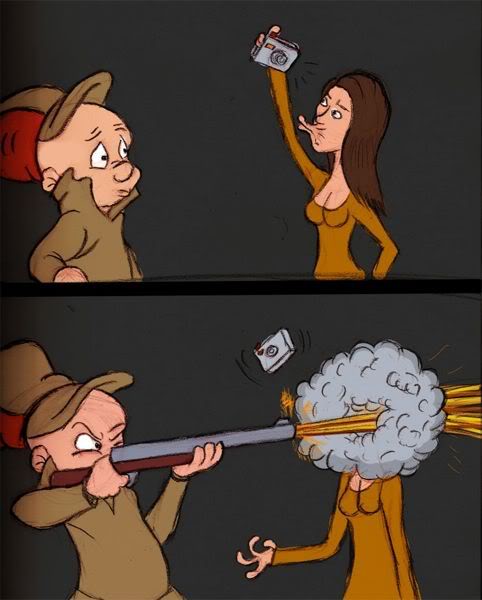
Consider Anderson Cooper who was a CIA intern before becoming a CNN journalist shill for the New World Order (NWO). He is the son of famous fashion designer Gloria Vanderbilt who is a member of the Vanderbilt Illuminati crime family. Cooper is now on a public anti-gun kick without finding out the truth about massacre shootings like Sandy Hook because he is not interested in the TRUTH--he is yet another bad faith actor. He is a classic Illuminati snob.
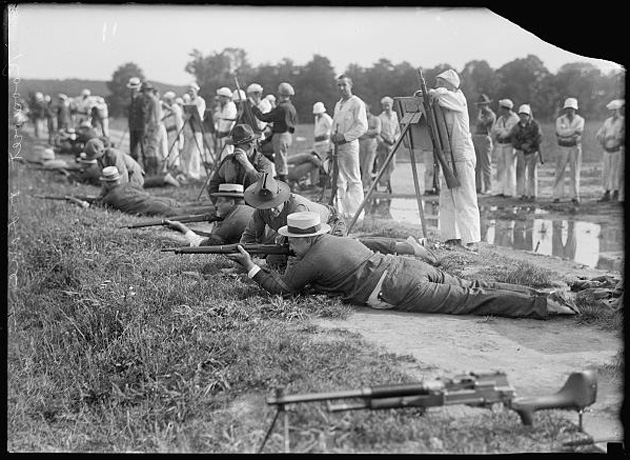
Even POTUS FDR knew the value of having military rifle skills...
The Illuminati know that armed citizens will not tolerate being herded into FEMA death camps like the naive liberal Jews were in Nazi Germany. Daniel Craig's movie Defiance is a good reminder of how strong people should react to tyranny that seeks to exterminate us.
 youtube.com/watch?v=n-9eUXSzZNk
youtube.com/watch?v=n-9eUXSzZNk
Of course the people who think they are above the law will not hesitate to shoot YOU with rifles...
http://news.yahoo.com/trooper-fired-chopper-stop-truck-kills-2-013027265.html
Trooper fired from chopper to stop truck, kills 2By CHRISTOPHER SHERMAN and JUAN CARLOS LLORCA | Associated Press - 13 hrs ago
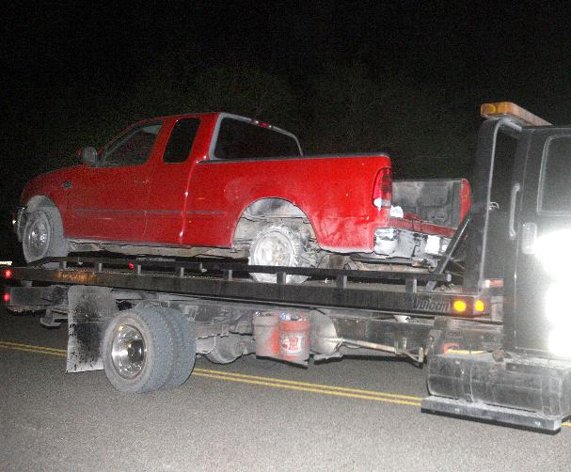
A red pick up truck is moved from the scene of a incident after a chase between law enforcement and suspected human smugglers on 7 mile road north of La Joya, Texas, Thursday, Oct. 25, 2012. Texas Department of Public Safety sharpshooter opened fire on an evading vehicle loaded with suspected illegal immigrants, leaving at least two people dead, sources familiar with the investigation said. (AP Photo/The Monitor, Joel Martinez)
LA JOYA, Texas (AP) - A Texas state trooper who fired on a pickup truck from a helicopter and killed two illegal immigrants during a chase through the desert was trying to disable the vehicle and suspected it was being used to smuggle drugs, authorities said Friday.
The disclosure came a day after the incident that left two Guatemalan nationals dead on an isolated gravel road near the town of La Joya, just north of the Mexico border.
State game wardens were the first to encounter the truck Thursday. After the driver refused to stop, they radioed for help and state police responded, according to Parks and Wildlife Department spokesman Mike Cox.
When the helicopter with a sharpshooter arrived, officers concluded that the truck appeared to be carrying a "typical covered drug load" on its bed and was travelling at reckless speeds, police said.
After the shots were fired and the truck's tires blown out, the driver lost control and crashed into a ditch. State police said a preliminary investigation revealed that the shots fired from the helicopter struck the vehicle's occupants.
Eight people who were in the truck were arrested. At least seven of them were also from Guatemala. No drugs were found.
The Guatemalan consul in McAllen, Alba Caceres, told The Associated Press that the surviving witnesses told her "one died immediately, the other was apparently taken to a hospital and died on the way."
The sharpshooter was placed on administrative leave, a standard procedure after such incidents.
An expert on police chases said the decision to fire on the truck was "a reckless act" that served "no legitimate law enforcement purpose."
"In 25 years following police pursuits, I hadn't seen a situation where an officer shot a speeding vehicle from a helicopter," said Geoffrey Alpert, professor of criminology at the University of South Carolina. Such action would be reasonable only if "you know for sure the person driving the car deserves to die and that there are no other occupants."
In general, he said, law enforcement agencies allow the use of deadly force only when the car is being used as a weapon, not "just on a hunch," Alpert added.
The Texas Department of Public Safety referred questions about its policy governing the use of deadly force to its general manual, which says troopers are allowed to use such force when defending themselves or someone else from serious harm or death. Shooting at vehicles is justified to disable a vehicle or when deadly force is deemed necessary.
Other law enforcement agencies that patrol the border say they have similar limits on the practice.
For instance, federal Customs and Borders Protection agents "are trained to use deadly force in circumstances that pose a threat to their lives, the lives of their fellow law enforcement partners and innocent third parties," agency spokesman Doug Mosier said.
But a report presented Thursday to the United Nations by the American Civil Liberties Union said shootings and excessive force by Customs and Border Protection agents on the border have left at least 20 individuals dead or seriously hurt since January 2010.
Of those, eight cases involved agents responding to reports of people throwing rocks. Six involved people killed while standing on the Mexican side of the border.
In recent years, Texas state police have increased their presence in the border area, deploying more agents, more helicopters and more boats to patrol the Rio Grande.
Troopers are regularly involved in high-speed pursuits, often chasing drug smugglers into the river and back to Mexico.
Agency Director Stephen McCraw has said state police were pushed into that role because the federal government's efforts to secure the border have been insufficient.
Diplomats quickly began their own investigation into the chase.
The head of the Guatemalan Consulate in McAllen said she is demanding federal and state authorities provide an explanation.
"I am baffled. I can't understand how this could happen," Caceres said. "I understand that the agents are doing their job, that they are protecting their border. But if there is someone who is responsible for this, he has to pay."
The Guatemalans started their journey 19 days ago near Guatemala City, with plans to stay with friends and relatives in New York, New Jersey and Houston, she said.
They were covered with a tarp, but as the car sped away from the game warden and the helicopter, the men "were having lots of trouble holding on to that tarp", Caceres said. "They must have seen them."
Another good DIY reading comes from former Delta Force/CAG Soldier Paul Howell:
 scribd.com/doc/124678360/Paul-Howell-LEADERSHIP-and-TRAINING-for-the-FIGHT
scribd.com/doc/124678360/Paul-Howell-LEADERSHIP-and-TRAINING-for-the-FIGHT
NEW! USN LCDR's STUDY on U.S. Military Small Arms Failures
www.combatreform.org/Ammo_Time_for_a_Change_US_Military_Small_Arms_Ammunition_Failures.pdf
 youtube.com/watch?v=O34Dxv788_I
youtube.com/watch?v=O34Dxv788_I
Farther south in open terrain desert and urban Iraq, 5.56mm rifles against enemies with AKMs in 7.62mm and rocket propelled grenades and explosives for roadside bombs (land mines) are attriting American troops on a daily basis. Since both the Army and marines are ill-led by light infantry narcissists who limit themselves to just what can be carried in the arms or rolls on sexy wheeled trucks, we continue to be out-gunned on the non-linear battlefield when we should be hands-down superior in all aspects of mobility, firepower and protection by having multiple armor layered, autocannon and large cannon equipped light M113 Gavin, medium Bradley and heavy Abrams tanks integral to every rifle squad in both light and heavy units. The weight of the vehicles differ in that light troops must be able to do 3D maneuver through and over closed terrain, and heavy troops over open terrain. Nevertheless, egos come first and feeble and absurd attempts are underway to believe it or not give short-range shotgun shells more power (USMC) and to field "smart" 25mm grenade launchers (U.S. Army) after we advised that the OICW rifle/grenade launcher combination was unworkable, when the problem is we lack our own RPGs in the rifle squad. We want to kinetic energy gun-sling badly while the enemy refuses to come out and play choosing to command-detonate land mines with high explosives instead.
Notice Army/marine foot infantry narcissists will do anything than admit they need RPGs (dedicated AT weapon that
So they will try to hand-carry a bit of explosives in short-range shotguns while overlooking the fact that to use it they have to expose themselves on foot even shooting from behind the cover of a pile of rubble. The M25 is nothing more than a hand carried autocannon with the same drawbacks as the more potent shotgun.
Notice to what lengths the egomaniacs will go to preserve their style/fashion and avoid the best functional arrangements that bruise their egos. Tracked vehicle autocannon and RPGs will do a better job than shotguns and grenade launchers.
However, before we turn the entire U.S. military's small arms set-up on its head to react to the current situation and battle conditions in one or two parts of the world, let us pro-actively examine how we got to where we are today in the Mandarin DoD "cookie cutters" lacked battlefield "reality check"
News about Weapons of the World at StrategyPage.com's How to Make War.
WEAPONS OF THE WORLD: Super Shotguns in Iraq
May 13, 2005: American troops are testing a 12 gauge automatic shotgun in Iraq. The Auto Assault 12 (AA12) has a rate of fire of 300 rounds per minute and uses either an 8-round box magazine or a 20 round drum magazine. Recoil on the system has been reduced to that of a light rifle, due to a sophisticated recoil system. The low rate of fire makes it possible to easily fire bursts of one, two, or three shots and is capable of using and mixing all types of 12 gauge ammunition, from shot to solid slugs, as well as non-lethal rounds. Allegedly, Iraqi insurgents have little respect for the M4 rifle and the 5.56mm round, but they fear shotguns.
If that's not enough of a firepower increase at the squad level, the marine corps is testing a family of 12 gauge shells designed to deliver blast, fragmentation, and high-explosive armored piercing projectiles out to 200 meters. The high-explosive armor-piercing projectile uses a shaped charge that has been demonstrated to put a 1 inch hole in quarter-inch steel plate. A total of 100 projectiles have been bought for testing as well as some quantity for "experimental use" in Iraq.
At first glance, packing an armor-piercing charge into a 12 gauge round sounds like overkill, but Iraqi terrorists are becoming increasingly sophisticated in fortifying themselves, vehicles, and fixed positions. Foreign fighters are using Russian-style body armor in their raids. Suicide bombers driving vehicles often wear body armor for protection until they get "on target" and some vehicles have been reportedly hardened with bullet-resistant glass and armor plate. In one incident, terrorists in a basement/crawlspace used a Russian machine gun equipped with armor-piercing rounds to shoot through a concrete floor to attack marines. The American troops had no effective way of firing back and ultimately had to call for an air strike with a 500 pound smart bomb to eliminate the resistance.
A combination of 12 gauge armor-piercing rounds with a shotgun would provide a weapon capable of effectively stopping an up-armored vehicle or larger truck without the extra weight and expense of a dedicated anti-tank weapon. It would also provide an enhanced capability in urban warfare with a convenient and familiar method of employment. - Doug Mohney
May 3, 2005: Six XM-25 grenade launchers have been delivered to the U.S. Army for troop testing. So far, the troops have been very enthusiastic about the new weapon. The XM-25 was originally one of two weapons (the other being a 5.56mm rifle) incorporated in the 18 pound XM-29 OICW. The OICW was originally developed as a replacement for the 40mm grenade launcher. The 40mm rounds weigh 19 ounces each, the 20mm OICW round weighs half that. There were several major problems with the OICW. It was too heavy and ungainly, and the 20mm "smart shell" it fired did not appear capable of effectively putting enemy troops out of action. So, in August, 2003, it was decided to take the 5.56mm portion of the OICW and develop it as a separate weapon (the XM-8) and develop the grenade launcher part that fired the "smart shell" as the XM-25. But the XM-25 would use a 25mm shell, which would generate 50 percent more fragments (and heavier ones at that) than the 20mm shell of the OICW.
The 20mm and 25mm "smart shells" use a computer controlled fuze in each shell. The M-25 operator can select four different firing modes via a selector switch on the weapon. The four modes include "Bursting" (airburst). For this to work, the soldier first finds the target via the weapons sighting system. The sight includes a laser range finder and the ability to select and adjust the range shown in the sight picture. For an air burst, the soldier aims at an enemy position and fires a round. The shell is optimized to spray incapacitating (wounding or killing) fragments in a roughly six meter radius from the exploding round. Thus if enemy troops are seen moving near trees or buildings at a long distance (over 500 meters), the weapon has a good chance of getting them with one shot. M-16s are not very accurate at that range, and the enemy troops will dive for cover as soon as M-16 bullets hit around them. With smart shells, you get one (or a few) accurate shots and the element of surprise.
The other modes are "PD" (point detonation, where the round explodes on contact), PDD (point detonation delay, where the round detonates immediately after it has gone through a door, window or thin wall) and "Window", which is used for firing at enemy troops in a trench, behind a stone wall or inside a room. The round detonates just beyond the aiming point. For buildings, this would be a window or door frame, cave entrance or the corner of a building (to get enemy troops thought to be around the corner.)
The XM25 is still a heavy weapon, with the final version coming in at nearly 18 pounds
. The 25mm shells weigh over half a pound each. On the plus side, there is already a 25mm armor piercing round (using a shaped charge capable of penetrating over 50mm of armor) available. This makes the M-25 capable of knocking out light armored vehicles.
The U.S. Army has fired over 30 million 25mm shells from the cannon on its M-2 Bradley armored vehicles and was satisfied with the lethality of that shell against infantry. One of the new options with the XM-25 25mm round is a fuel-air explosive (or "thermobaric"). Such a shell would cause greater blast effect in an enclosed space, and actually suck most of the oxygen out of a cave or closed room long enough to make surviving troops at least a bit groggy. This gives the attacking troops an opportunity to rush in and kill the enemy, or take prisoners. In combat, every little advantage helps.
Sadly, the U.S. military is a 19th century culture based on blind obedience instead of thinking, individual professionalism, run by careerist mandarins who have other, bureaucratic agendas than providing the best equipment to our troops. Their goal is to keep order and simplify logistics so they do not have to be bothered or have their budgets and powers questioned. They want a single caliber type for industrial base production for a large force in human terms, but compared to other world armies is a tiny outfit. However, there is no one-size fits-all cookie cutter in bullet or armored vehicle size--as events like the tragic and preventable Humvee/Stryker deaths have proven to us time and time again.
The reason why we cannot go with a single compromised rifle cartridge is because of the nature of the earth itself is either a closed-by-vegetation or buildings or open terrain type; this reality should drive weapons optimization--not the bureaucracy's laziness and false assumption that a single war weapon type can be optimized in two directions at the same time--to meet two different set of conditions. Whatever can be done in one optimal direction can also be done better in the other, so if you try to do a little of both you will actually be sub-optimized for BOTH situations! This is why defacto, our foot infantry, sustained, base-of-fire machine guns fire is a large 7.62mm x 51mm cartridge while the maneuvering rifle troops fire a smaller 5.56mm x 45mm cartridge.
In closed terrains (like jungles) you will suddenly happen upon the enemy and need lots of bullets to suppress and kill. To get a lot of bullets firing fast, to include full automatic or bursts---we have realized that a scaled-down rifle cartridge, shot selective fire through an "Assault Rifle" (AR) attains this; the AKM shooting 7.62mm x 39mm (later 5.45mm) and the M16 firing 5.56mm x 45mm cartridges are the world standards for this. The stereotypical "AK-47 versus M16" gunfight is best depicted in the recent film, "We were Soldiers" recreating the
After the Vietnam war, the U.S. relearned that it still had global responsibilities to fight in--not just closed terrains, but in open areas like the plains of Europe, deserts and mountains as the
Afghanistan: Self-Inflicted Style Lacks Substantive Range

 scribd.com/doc/124758039/XM8-vs-M4-5-56mm-Comparison-Moot
scribd.com/doc/124758039/XM8-vs-M4-5-56mm-Comparison-Moot
In the years after DESERT STORM, the need to fire accurately created a plethora of advanced optics and collimator sights that even the trusty M16's top carry handle center hole/rail could not keep up with. To laser point or shine a flashlight, the beam must be closer to the barrel so the Knight Armament Picatinny Rail system at the rifle's fore-end was fielded by U.S. Army Special Forces in the SOPMOD kit. However, while improving the MENTAL means which bullets are directed, the PHYSICAL means were diminished by fitting these things to a short-barrel, telescoping stock version of the M16 called the M4 carbine. While a Paratrooper or a SF trooper may need a shorter weapon to enable parachute jumps with shortened carrying cases and better foot mobility, it comes at a cost: range is reduced to just 500 meters. When coupled with the attachments, the short M4 carbine does indeed look "sexy" and is handy for tight quarters fighting like in urban settings. However, the mandarins true to form, decided to outfit not just SF and the Airborne, but the rest of the Army's Light Infantry with the short-barrel M4; returning us right back to where we were in physical range at the end of the Vietnam war: a half-kilometer jungle rifle!
Along comes the CIA-created "terrorist" 9/11 attacks and we send SF in, but not the Airborne in mass to seal off the Pakistani/Afghan border--so the enemy escapes. We "discover" that the M4 carbine lacks the range to reach across the valleys to hit the enemy's stay-behind troops who drop mortars and fire heavy machine guns that pin us down from getting close to engage with our defacto jungle carbines. We shortened M16, then wonder why we lack range? We should be fighting in Afghanistan with the full-sized M16A2 and to employ laser aimers etc. its fore-end should have the Picatinny rails, making them "M16A4s" in order to have 800 meter range. 5.56mm bullets without the steel penetrator core for man-stopping should be supplied to our troops in contact. The full-stock M16A4 can also be used as a stick when climbing up steep terrains and be fitted with a
There will be some that will cite how overloaded we are and how having the short-barrel M4 carbine helps; to this I answer if we do not get the rucksack off our backs whether we have ARs or carbines or even MBRs will be moot point; we will be trudging along at 1 mph while the enemy shoots and scoots at 4-7 mph, Ia Drang style to hit us at will or run away. The solution is to ditch the rucksacks and live just from your buttpack, "
Retrotech reactions still seeking "cookie cutter" single cartridge compromise when we need optimization
In the aftermath of
Stop for a minute and ponder this before reading further.
The U.S. Army is placing its future success on the Objective Individual Combat Weapon or "
Stoner's Direct Gas System Must be Fixed
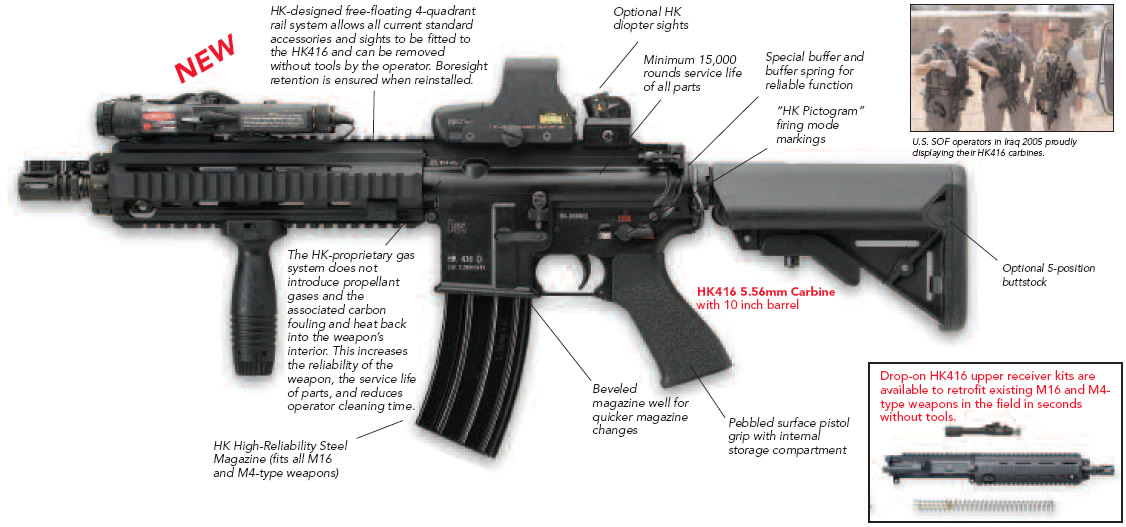
 youtube.com/watch?v=jPeYijje8Bs
youtube.com/watch?v=jPeYijje8Bs
 youtube.com/watch?v=-gnZWjqI8RQ
youtube.com/watch?v=-gnZWjqI8RQ
Again, the painful truth; the M16/M4 family has been plagued since their inception with a direct gas system that blows dirty carbon into the chamber area resulting in clogging and jams and constant cleaning (see videos above).
 slideshare.net/1st_TSG_Airborne/m4-carbine-extreme-dust-test-brief-v350
slideshare.net/1st_TSG_Airborne/m4-carbine-extreme-dust-test-brief-v350
 scribd.com/doc/123124915/PS-Magazine-M16-M4-Cleaning-Tips-2008
scribd.com/doc/123124915/PS-Magazine-M16-M4-Cleaning-Tips-2008
The HK 5.56mm assault rifle wed to OICW sneaks it into the Army system as a new purchase, a "fix" to the M16/M4 family in typical mandarin, let's-spend-a-lot-of-money-to-soak-up-more-bureaucratic-power fashion. Then once, the OICW is fielded, the Army could buy HK 5.56mm assault rifles without the smart 20mm grenade launchers and throw away their M16s/M4s and 4-decades of expertise and training.
We vehemently reject this course-of-action (COA) since we will still when all is said and done be stuck with a short-range jungle assault rifle albeit with an excellent smart grenade launcher. We are still not optimized for open terrain or urban combats.
Over in the marine camp, there is talk of adopting the M4 SOPMOD as their future rifle (Why if you are so dis-satisfied with 5.56mm range in Afghanistan operations? Just to look as sexy as Army lightfighers?) and to pull some M14 7.62mm MBRs out of war stocks to outfit a designated rifleman in each rifle squad. The French Army and others have had a 7.62mm MBR sharpshooter with a long-range optic in their rifle squads for at least 3 decades, maybe more, yet we act like this is somehow "revolutionary". What we are doing is simply catching up, what I propose is really "transformational", to use the latest sexy DoD buzzword.
The Solution is to adapt to optimize for BOTH closed or open terrains
First, separate the OICW into rifle and smart grenade launchers. Do not buy HK 5.56mm assault rifles with gas piston system to hide M16/M4 failings, instead use the saved money to retrofit gas piston systems to ALL M16/M4s, facing the problem HEAD-ON and solving it instead of covering DoD mandarin ass for failure over the years to improve the reliability of these otherwise superb weapons. For a proven way to do this, look at Allan Zitta's LR300 weapons:
Z-M Weapons, High Performance Systems
203 South Street
Bernardston, Massachusetts 01337
Tel: 413-648-9501 Fax: 413-648-0219
email: zm@zmweapons.com
Compact Assault Rifle - 5.56x45mm NATO - USA - 950 RPM - The LR300 M/L is a compact conversion of the M16/AR15 family. Allan Zitta has designed an entirely new upper receiver which uses an Armalite AR18 style gas piston and relocates the recoil spring over the barrel. The latter feature allows the elimination of the M16/AR15 buffer tube, and provides the base for a folding stock. The resulting product is more compact and reliable than the M4 Colt Commando. By placing the recoil springs on the front of the weapon, the M16/M4 can still use a telescoping stock for compactness, though with a full-length barrel for 800m range.
What the M4A2 and M16A4 should somewhat look like:
Will the Grenadier with stand-alone OICW 20mm GL mean a loss of 5.56mm firepower in the squad?
No, have him carry a M4 carbine or better yet a "M16A5".
Won't this be heavy?
It'll be exactly the same "heavy" as having the two weapons physically attached, except sans the bureaucratic hidden agenda, he will have a lighter weight, easier to employ grenade launcher and when he needs to shoot direct-fire, he will have a lighter weight 5.56mm assault rifle.
Next, we need the long-barrel 5.56mm M16A4 type weapons in at least our "Medium" and "Heavy" mechanized units that ride into battle by armored vehicles. Since the M4 and the M16 are similar, we should be able to as the situation dictates, outfit light units with them if they need the 800m extra range as they do now in Afghanistan.
1st Tactical Studies Group (Airborne) Director Mike Sparks writes: "I have never liked the M4 carbine; I have always wanted a full-sized M16A2 with a 20 inch barrel that turns the 5.56mm bullet more than TWICE before leaving for full muzzle velocity. I don't find the long M16A2 troublesome to carry; put Picatinny rails on it and make it a 'M16A4'.
We should if we want a shorter 5.56mm find a M16 gas piston system and create a M16/M4 bullpup or a real folding stock with an ability to eject away from us lefty's face or move the action spring(s) to the front for a folding/telescoping stock that has a full length, 20+ inch barrel and Picatinny rails for all the gizmos we can dream of instead of sacrificing barrel length like we do on the M4. I said this at the time in 1995 and was poooh-poohed with the old saw that we will only have to shoot to 200 meters etc. etc. I DON"T @#$%$^% CARE WHAT YOU THINK I WILL NEED; I WANT 800M RANGE ON MY M16A2+ WHEN ITS MY ASS ON THE LINE. I will hump the extra length and weight without complaint. I want the long barrel.
I suspect a lot of the desire for the M4 is to LOOK SEXY because "common" troops in "support" units have M16A2s etc. etc. I don't care about who feels sexy or not, and am glad the troops have capable M16A2s, and want what's BEST, period. I am special because I am a one-of-a-kind human being made in the image of God (like you) 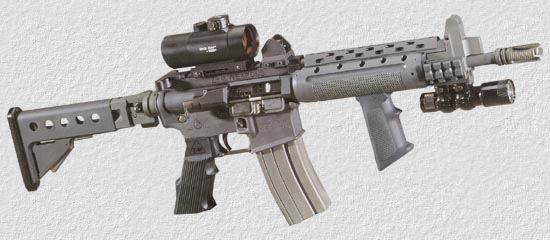
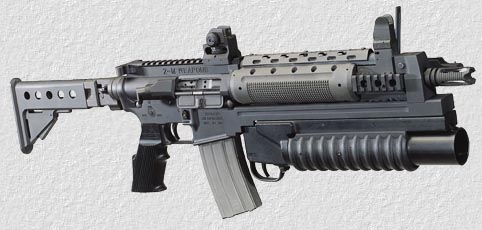
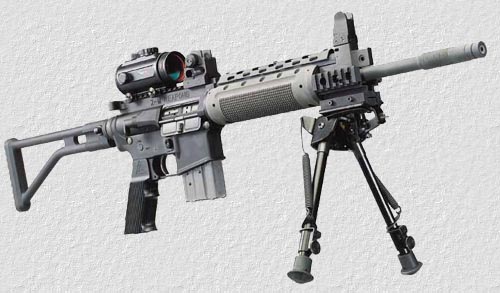
The Answer is a M16A5: Inter-changeable 5.56mm, 7.62mm Weapons Family
Jane's IDR October 2002, "Small arms ammunition advances bit by bit" by Charles Q. Cutshaw on Pages 36-37 reports:
"There have been several reports from troops in Afghanistan regarding the lack of lethality of the SS109/M855 cartridge, particularly when it is fired from an M4 (US) or M8 (Canadian) carbine. This was also observed in Somalia. For the SS109/M855 to achieve lethality, it must be moving at a velocity of over 732m/s when it strikes its target. At this velocity and above, the bullet penetrates a short distance and then begins to yaw as its spinning slows and it tends to return to normal stable state, which is base forward. As the bullet yaws, it comes apart at the cannelure, scattering fragments and causing a relatively large wound channel. In practical terms, this translates to approximately 200m with a bullet fired from an M16 or similar rifle with a 558mm barrel at approximately 914m/s.
When fired from a carbine, however, the SS109/M855 bullet leaves the barrel with a velocity of only about 790m/s. Therefore by the time it has traveled downrange only 50m it has already dropped below the velocity threshold for enhanced wound ballistics. The net effect is that troops equipped with M4 or M8 carbines are using weapons that are only marginally more effective ballistically than a 0.22 Magnum at anything other an close-quarters battle distances.
The lack of wounding efficacy has caused some military elements to begin exploring the possibility of adopting a 5.56x45mm cartridge with an improved bullet or even a different caliber like 6.8mm altogether with improved wound ballistics. Most of these efforts, now only in the earliest stages, have experimented with heavier bullets. For example, U.S. special operations forces in Afghanistan now employ a match cartridge manufactured by US company Black Hills Ammunition that fires a 5g bullet at 792m/s in the M4 Carbine. This cartridge has proven to have improved terminal ballistics over the SS109/M855. Other experiments have been conducted with bullets weighting as much as 6.5g. Some have proposed adopting an entirely new caliber, but this is unlikely in the immediate futures."
There is a reason why we propose we go to great lengths to fix the M16/M4 gas system with a piston; these weapons have a unique upper receiver/lower receiver construction that facilitates modularity that can be used to ADAPT to the battlefield to attain physical, situational superiority. In every U.S. Army rifle squad regardless of heavy or light there should be a "Designated Sharpshooter" with a 7.62mm M16 which can be achieved via a new upper receiver, new bolt carrier group and new magazine that narrows at the top from double to single row for feeding. Remember, before there even was an "AR-15" (M16) there was the AR-10 in 7.62mm x 51mm. We can do this, its already being done as you can buy AR-15s that shoot full-size 7.62mm cartridges (re: the KAC SR-25 called the "Mk 11 Mod O" in USN SEAL team use). By having a smart OICW grenadier with indirect-fire for top-attack, and a long-range defacto sniper with a strong strike-at-1km range capability, the rifle squad can in the face of long range enemies get suppressive fires onto them. Army SF realizes the M16/M4 carbine's adaptability and for their Phase II SOPMOD has an upper receiver module shooting 6.8mm (!) cartridges for greater range/striking power though it means introducing an entirely new ammo type which the DoD mandarins will likely resist. Why go to 6.8mm when we already have more powerful 7.62mm in the system and in every Army infantry company?
Furthermore, the inclusion of a 7.62mm "M16A5" gives everyone in the squad a chance to familiarization-fire the weapon each year such that in event that their 5.56mm M16/M4s prove inadequate to the task at hand, they can be outfitted with 7.62mm M16A5s with the realization their weapon will fire with greater kick (recoil) and they will carry less ammo per man. One possible scenario is urban areas, while closed terrain where lots of bullets firing fast are needed to hit fleeting enemies and suppress, the buildings and walls prevalent are difficult to penetrate with 5.56mm bullets so larger bullets are needed to have effects on the enemy. The M16 becomes actually two rifles; either an AR or a MBR as the situation dictates. The Army's 4 decades of expertise with these weapons is not pissed away and new capabilities are gained. However, the willingness to optimize also means accepting "help" from other combat arms units and different weaponry types.
 Got Ammo?
Got Ammo?
On the non-linear battlefield, 
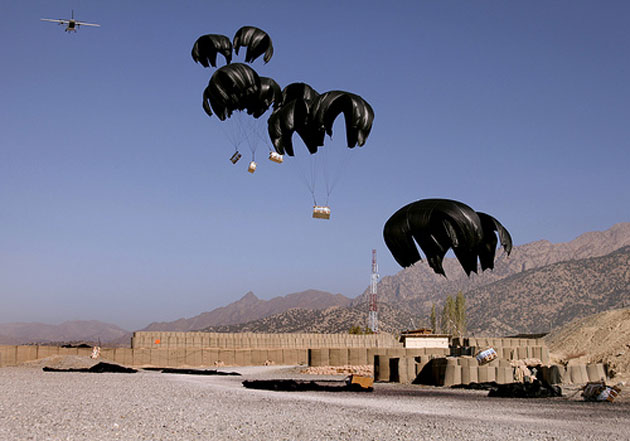
The Cammenga M16/M4 30-round magazine that can be rapidly reloading in one procedure is a great idea but we have thousands upon thousands of regular magazines that don't have this loading feature.
 youtube.com/watch?v=p-OD9GLOY0k
youtube.com/watch?v=p-OD9GLOY0k
To speed reloading in a firefight the M16A5 should have its upper receiver able to feed STRIPPER CLIPS DIRECTLY like we can with the FN FAL main battle rifles
 youtube.com/watch?v=zG8o4JJ1IXM
youtube.com/watch?v=zG8o4JJ1IXM
And the M14. The new BullDog bullpup 7.62mm x 51mm NATO M14 is an amazing rifle with lots of promise that has already proven itself in combats in Afghanistan.
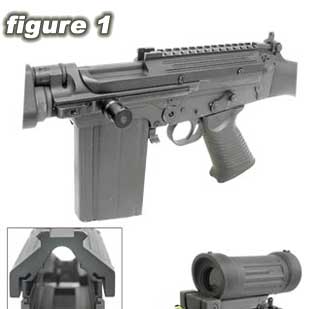


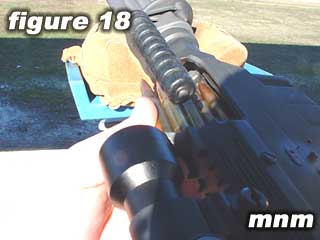
We have lost battles (Wake Island, Bataan, Coregidor) and wars (
We have captured untold thousands of enemy SKS and AKM weapons that could and should be accurized and fitted with rapid fire/night optics to be our "PLAN B" back-up guns held in our vehicles so even if resupply of U.S. ammo doesn't come through, we can keep on fighting & maneuvering using the enemy's ammo against him. This is standard guerrilla warfare practice so weakling lemming fucktards who cannot be self-reliant need to STFU and stop acting like egobabies dependent upon Mother Army to breast-feed them with American ammo for their M16/M4 hand idols.
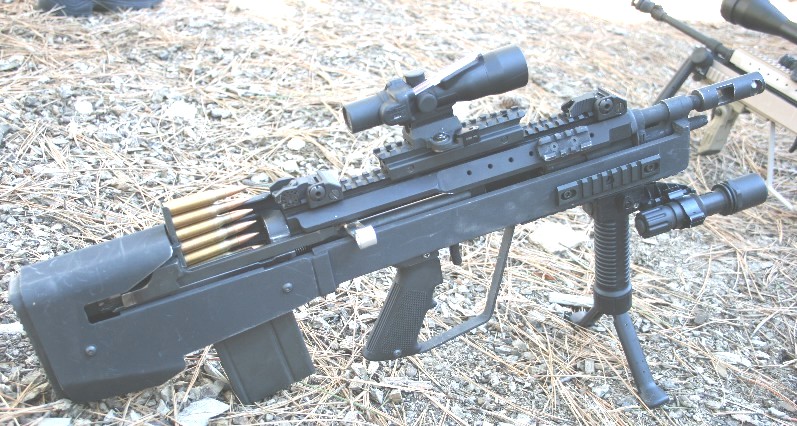


If we do it right, the M16A5 lower receiver would be standard and have an opening large enough to fit 7.62mm x 51mm NATO magazines. If you shoot smaller cartridges like 5.56mm, the magazine well is fitted with an adapter. This way, one common lower receiver can then fire either 5.56mm or up to 7.62mm upper receivers snapped in as the situation dictates. We could even have upper receivers so ENEMY 5.45mm and 7.62mm x 39mm cartridges could be fired if
Got Foreign Weapons Skills? A Back-Up Weapon to Fire Enemy Ammo? Combat is Not the Time for On-the-Job Training!
The Army Needs to Step-Up Training on Foreign Arms
BY MAJ. JIM TIERNEY
 youtube.com/watch?v=Xt7Zdp2W7eY
youtube.com/watch?v=Xt7Zdp2W7eY
 youtube.com/watch?v=_LJMvaggKZI
youtube.com/watch?v=_LJMvaggKZI
Just like we told you all along that Stryker and other wheeled trucks are road-bound crap--BEFORE THOUSANDS OF SOLDIERS WERE MURDERED AND MAIMED---we informed the general public that we need ALL of our Soldiers able to fire enemy weapons and use their own ammo against them--just like Major Tierney proposes in this month's Armed Forces Journal Magazine. Once we establish foreign weapons Subject Matter Experts (SMEs) in every Army unit, we will next need WEAPONS (dedicated model like a stripper clip and AKM magazine-fed SKS or a snap-on M16A5 upper receiver) to train on and be our back-ups in time of non-linear war--where resupply is not a given.
combatreform.org/ARMORHISTORY/thunderrun.htm
Its time the Army started providing Soldiers with formal training on the foreign weapons most commonly used either by the enemy or by friendly host-nation military and police forces. Nearly every conflict in which the Army has participated--including present-day operations in Afghanistan, Iraq and Africa--has included some mission requiring Soldiers to train host-nation forces. Yet we as an Army fail to adequately prepare today's trainers on how to conduct foreign weapons instruction to foreign militaries should the need arise.
Once largely the province of Special Forces, missions to train national armies, police and other extensions of the host-nation's government or other indigenous forces have proliferated in recent years throughout the Army's "conventional" units. Thousands of Soldiers and hundreds of units have deployed in support of operations ENDURING FREEDOM, IRAQI FREEDOM and NEW DAWN to conduct training under myriad transition teams. Throughout Africa and Europe, conventional units from both the active and reserve components routinely deploy to train and mentor hostnation militaries. Units train indigenous forces in small-unit tactics, which include individual and crew-served weapons training. Foreign-force adviser teams are routinely required to provide the host nation with basic and advanced marksmanship training. Additionally, they are required to track and assist in maintaining foreign-force equipment and weapons issued to the host-nation unit. Most weapons used by foreign-force military and police units are Soviet-style small arms such as the AK-series assault rifle, the PK-series machine gun and the DShK heavy machine gun. Yet, the Army offers no formal training to Soldiers on these or other weapons commonly found in the environments in which they operate. Soldiers tasked with the mission of providing small-arms instruction or weapons qualification must rely largely on dated manuals, Internet references and personal experience. The Army preaches composite risk management in all aspects of training and combat operations, yet when it comes to foreign weapons we turn a blind eye to safety. What would the ramifications be for a leader who not only put a weapon into the hands of a Soldier not trained on that weapon, but who also put that Soldier in charge of teaching others how to use it safely? This problem would be compounded by the trainees' own lack of safety awareness, which would further raise the risk for the students and instructor alike. [EDITOR: remember the marines that blew themselves up when they didn't properly load a RPG?]
KNOW THE ENVIRONMENT
Leaders conduct mission analysis using the METT-TC factors (mission, enemy, terrain and weather, troops and support available, time available, civil considerations) to make deductions about the enemy and his capabilities. The leader will use these deductions to drive operational planning and execution. Knowing whether the enemy's most effective casualty-producing weapon is a PKM medium machine gun or a DShK heavy machine gun will heavily influence the leader's decision-making about the tactical employment of his unit. Of equal concern would be the ability to distinguish those weapons in a cache. The lack of accurate and detailed reporting prevents situational understanding of the operational environment.
Maintaining a foreign-small-arms instructor at the unit-level would provide commanders with a resource to accurately identify weapons and ammunition found in caches or recovered during battlefield engagements. Foreign weapons instruction would assist the commander in determining standoff distances and force-protection levels, in creating effective engagement zones and in reacting to enemy-initiated actions.
The ability to identify foreign small arms becomes even more important during the inspection of recovered ammunition. Too often, units will report weapons in cache reports in a generic categorization ("AKs" or "assault rifles") or altogether incorrectly - for example, mistaking an AKM for an AK-74. The effects of a "standard" anti-tank rocket-propelled grenade versus a tandem or even thermobaric RPG are extremely different, and may portend the arrival of a new and more lethal weapon in the area of operations. The lethality of an armor-piercing incendiary round is greater than those of standard ball ammunition, and the presence of API rounds could affect a commander's decision about body-armor configuration - for example, full-vest or plate carrier for a given mission. Yet commanders are left blind to these and other differences that should have an impact on their mission command and decision-making.
Commanders already have several assets available, but none that are dedicated to providing foreign small-arms expertise. For example, commanders are often provided "slice elements" such as explosive ordnance disposal and weapons technical intelligence teams, but the primary missions of these elements fall outside this lane. Weapons intelligence teams are primarily technical-intelligence teams-the initial scope for these teams included improvised explosive devices as well as conventional weapons, but their emphasis has been on IED exploitation. So although all of these teams are valuable assets, they do not negate the need for a conventional foreign-small-arms asset at the company level.
IN TIME OF NEED
U.S. service members need to be prepared to win in battle despite overwhelming odds. Soldiers engaged in combat operations need to know how to correctly employ the foreign weapons when required, such as when a Soldier's own weapon is rendered inoperable or a lack of ammunition requires him to use the enemies' weapons - not only to survive but to defeat the enemy.
Col. James Coffman was awarded the Distinguished Service Cross after a lengthy battle on Nov. 14, 2004, in Mosul, Iraq, while assigned as the senior adviser to the 1st Iraqi Special Police Commando Brigade. At one point, an enemy round shattered Coffman's shooting hand and rendered his M4 rifle inoperable. After bandaging his hand, the colonel picked up AK-47s from commando casualties and fired them with his other hand until they ran out of ammunition.
Then-1st Lt. Brian Chontosh was awarded the Navy Cross for his actions while assigned to the 1st marine expeditionary force in Iraq on March 25, 2003. When his unit came under fire from enemy fighters occupying a nearby trench, Chontosh began to clear the trenchline. After his own ammunition was depleted, he twice picked up discarded enemy rifles and engaged the enemy. When a marine following him found an enemy RPG launcher, Chontosh used it to destroy yet another group of enemy soldiers. When his audacious attack ended, he had cleared more than 200 meters of the enemy trench, killing more than 20 enemy fighters and wounding several others.
THE MARINE CORPS MODEL
The marine corps offers a standard baseline in foreign weapons training that the Army should offer as well. Each marine infantry officer undergoes familiarization training as part of the Basic School's Infantry Officer Course. According to the course introduction, students receive this training because each officer must have a working understanding of the potential threats, capabilities and limitations enemies bring to the battlefield.
The Foreign Weapons Instructor Course (FWIC) offered by the Weapons Training Battalion at Quantico marine corps base in Virginia is a 2-week course with three goals:
* Provide unit commanders the capability of having a foreign-small-arms instructor on hand throughout a deployment.
* Provide students the skills necessary to return to their units and instruct other marines on the use of the most commonly found foreign weapons.
* Assist the unit commanders' ability to give weapons instruction to foreign militaries should the need arise.
In addition, the FWIC provides a comprehensive overview of several foreign weapons, including the AK-series assault rifle, the G3 and FN FAL battle rifles, the SVD-designated marksman rifle, the RPK light machine gun, and the RPD and PK medium machine guns. The selection of these weapons was intentional - they are some of the most commonly used weapons worldwide, and they are used by both friendly and enemy forces. The course also provides overviews on RPGs, DShK heavy machine guns, 82mm mortars, numerous other small arms and ammunition, and the principles of small arms and ballistics.
Although Soldiers can attend the marine corps FWIC, priority rightly goes to marines. The Army should adopt a similar additional skill identifier-producing course to provide units with school-trained foreign-weapons instructors. The Army version of an FWIC should not be designed as a replacement for the longer and more-exhaustive 18B course (Special Forces weapons sergeant); rather, it should focus strictly on those weapons a conventional soldier will be asked to teach as part of an established transition team.
RECOMMENDATIONS
The Army should embrace foreign-weapons training as a standard of training for maneuver units and units assigned as foreign-force advisers. Foreign-force advisers are currently being drawn from the total force of Army, Navy, Air Force and marines. This shift of a once-unconventional mission to the conventional forces requires the Army to ensure that Soldiers are adequately prepared to succeed. Recoinmendations include the following:
* Incorporate foreign-weapons training into the Maneuver Captain's Career Course and the Infantry Officer's Basic Course. Early familiarization with foreign weapons and their effects will provide a more adaptive officer corps.
* Institute a foreign-weapons instructor course. Create an additional skill identifier for graduates of the course. This course should train Soldiers on the characteristics, assembly and disassembly, zeroing, firing and maintenance of common foreign weapons, to include the AK-series assault rifle, the G3-series rifle, the SVD "Dragonuv"-designated marksman rifle, the RPK light machine gun, the PK medium machine gun, the DShK heavy machine gun and the RPG-7. The course should also train Soldiers on the identification and characteristics of small-arms ammunition.
* Create authorized positions for the FWIC additional skill identifier throughout a brigade combat team.
* Maximize training on foreign weapons for maneuver brigades and below deploying overseas. Require foreign-weapons training for all units serving in an advisory role to a foreign force, such as a military or police unit.
SUMMARY
As leaders, we would be remiss if we put a Soldier who lacked formal training behind a weapon. Soldiers deploying into a theater of operations are required to qualify on their individual weapons prior to even leaving the continental U.S. (And even that isn't always enough - many units were also subject to requalification in Kuwait before crossing into Iraq). Yet we currently deploy Soldiers without providing them any formal foreign weapons training at all. The Army needs to implement formal training on foreign weapons for three reasons: first, to ensure that our soldiers are prepared when serving as advisers or as part of a training team tasked with enabling foreign forces, such as the Afghan National Army or Iraqi National Police, to become more professional; second, to help leaders understand their environment, the enemy and the enemy's capabilities; and third, to provide Soldiers the ability to use the enemy's weapons against him in time of need (e.g., the inoperability of an individual weapon or the depletion of ammunition). Not preparing our Soldiers in how to safely and successfully employ the most common foreign weapons creates a risk we should no longer be willing to accept.
__________________________
MAJ. JIM TIERNEY is a U.S. Army officer assigned to the National Ground Intelligence Center in the Infantry & Mobility Branch, where he serves as a small-arms analyst. He has served in numerous infantry-duty positions in the 116th Brigade Combat Team (Virginia Army National Guard), including Weapons Company commander and S-3 for a light infantry battalion, with deployments to Afghanistan and Kuwait He is a graduate of the marine Corps' Foreign Weapons Instructor Course. The author wishes to thank the members of the NGIC Small Arms Team for their insights and expertise.
Camouflage, anyone? No More "Black Rifles!!!"
BAD BLACK RIFLES = BAD CAMOUFLAGE
GOOD CAMO RIFLE = GOOD CAMOUFLAGE

Can't PAINT your rifle because Garrison-mentality, non-tactical asshole 1SGs/SGMs won't let you? Use Camo-Form tape!
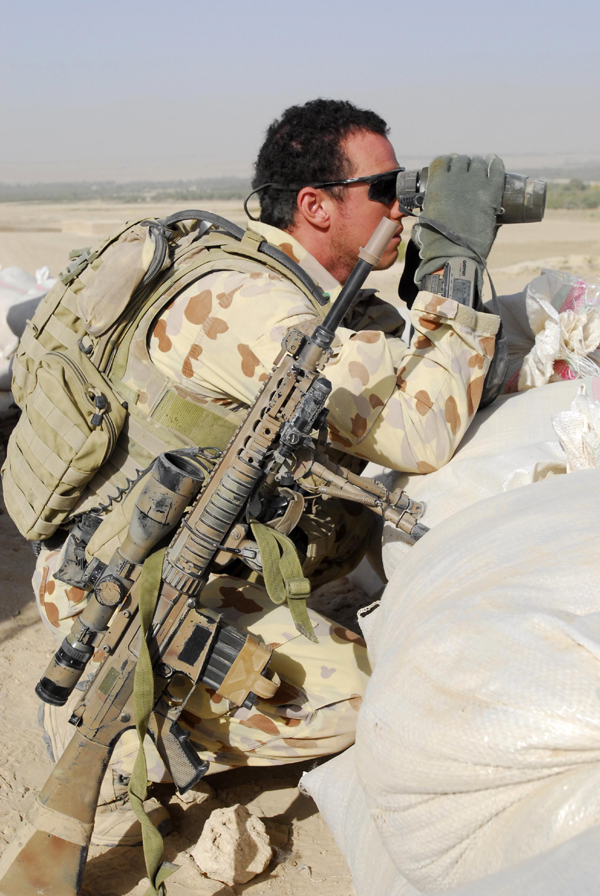
All M16A5 components should be parkerized in a TAN camouflage color to end this silly BLACK object-in-your-hand compromise of individual  youtube.com/watch?v=kCV29wVpNv0
youtube.com/watch?v=kCV29wVpNv0
 youtube.com/watch?v=Uy6yzETchD8
youtube.com/watch?v=Uy6yzETchD8
 youtube.com/watch?v=cN8wldEpQfY
youtube.com/watch?v=cN8wldEpQfY
Better, More Realistic COMBAT Shooting Skills--not BS USMC Known Distance Target Shooting!
Weapons handling, camouflage and magazine retention skills in the U.S. Army and USMC are woefully inadequate. Even with a gunslinger, narcissistic culture in place, we still shoot like its a sport of feel-good target shooting. Magazines need to be speed reloaded and retained through pull-carry loops.
Finally, the U.S. Army is going away from stupid BS USMC-style known distance target shooting towards COMBAT SHOOTING for war:
army.mil/-news/2008/03/27/8162-jackson-testing-new-weapons-qualification-method/
Mar 27, 2008 youtube.com/my_playlists2?pi=2&ps=20&sf=&sa=0&sq=&dm=0&p=AD33AEAB7CF03770#
youtube.com/my_playlists2?pi=2&ps=20&sf=&sa=0&sq=&dm=0&p=AD33AEAB7CF03770#
Jackson Testing New Weapons Qualification Method
BY Mike A. Glasch
Pvt. Abby Anthony, Company C, 2nd Battalion, 39th Infantry Regiment, kneels behind an L-shaped barrier on Range 10 during "Combat Shoot," an experimental Basic Rifle Marksmanship qualification course.
Photo by Mike A. Glasch
FORT JACKSON, S.C. (Army News Service, March 27, 2008) -- "One shot, one kill" may be the motto of the Army sniper, but for Soldiers qualifying in Basic Rifle Marksmanship, the traditional one shot per target on the range could soon come to an end.
The Basic Combat Training Soldiers of 2nd Battalion, 39th Infantry Brigade, are testing a new BRM qualification, which combines elements they will experience on the battlefield -- movement, concealment, presence of civilians and using multiple rounds on an enemy.
"This is to give Soldiers a qualification standard that is more combat focused," said Capt. Sammie Burkes, Company C commander. "It requires them to use those marksmanship skills they will encounter in a modern-day battlefield environment."
L-shaped barriers have been placed in front of the berms on the firing ranges. At the start of the "Combat Shoot," Soldiers are given four 10-round magazines. As they walk down the range on a simulated patrol, targets pop up and a loudspeaker blares the sound of shots being fired at them. Soldiers are required to engage multiple targets at different distances. The targets require one to three hits before they will go down.
"Lessons learned from Afghanistan and Iraq show that you may have to engage that target more than once before it goes down," Burkes said. "This will teach the Soldiers that lesson, versus the regular BRM where with one hit, a target goes down."
After the first round of targets, Soldiers rush to the barrier and change magazines, and repeat the scenario three times from behind the barrier -- standing, kneeling and prone positions.
Company C drill sergeant Staff Sgt. Randall Weeks said this gives Soldiers more realistic training.
"They are actually moving, needing to find cover and reloading just like they will have to do in Iraq," he said. "The old BRM didn't teach them that. They are moving more. Having to run up to cover gets their heart beating. Once your heartbeat increases it actually moves your weapon and affects your aim. You have to learn how to manage it."
During the last three scenarios a new twist is added. A target painted white appears representing a civilian. If a Soldier shoots the civilian, he or she is automatically disqualified.
"It's teaching the Soldiers to have a little bit of target discrimination," Burkes said.
"We've placed the civilian 'target' in the middle of the others," said Weeks. "The Soldiers have to look beyond it and aim in front and behind."
Another twist is dummy rounds loaded in the Soldier's magazine. They can be in one, two three or all four of the magazines. The dummy rounds are designed to simulate a weapons jam, requiring Soldiers to perform SPORTS (slap, pull, observe, release, tap, shoot) to their weapon in the middle of their BRM qualification.
Burkes said he hopes the "Combat Shoot" will eventually replace the current BRM qualification.
"We would like to see this become the qualification standard versus the way we qualify now," he said. "This is teaching Soldiers to have a little bit of target discrimination, to change magazines quickly, and that they may have to fire more than one round to put an enemy down. It keeps them more focused."
Weeks agreed with his commander's assessment. He said that training to the "Combat Shoot" standards makes his current group of Soldiers 100-percent better at BRM than previous cycles.
"We started teaching the techniques needed from day one of BRM. We had 100 percent of the company qualify (on the standard BRM) on the second day. In the past it would take all three days to get everybody qualified. That gives us a whole extra day of training," he said. "When they are in Iraq, they're not just going to be lying in a prone position or in a foxhole. They are actually going to have to learn how to get behind a car, or a wall and engage the enemy from around and over a cover."
Is this enough to prevail in Urban Combat? 90 Rounds Drums & 7.62mm Option
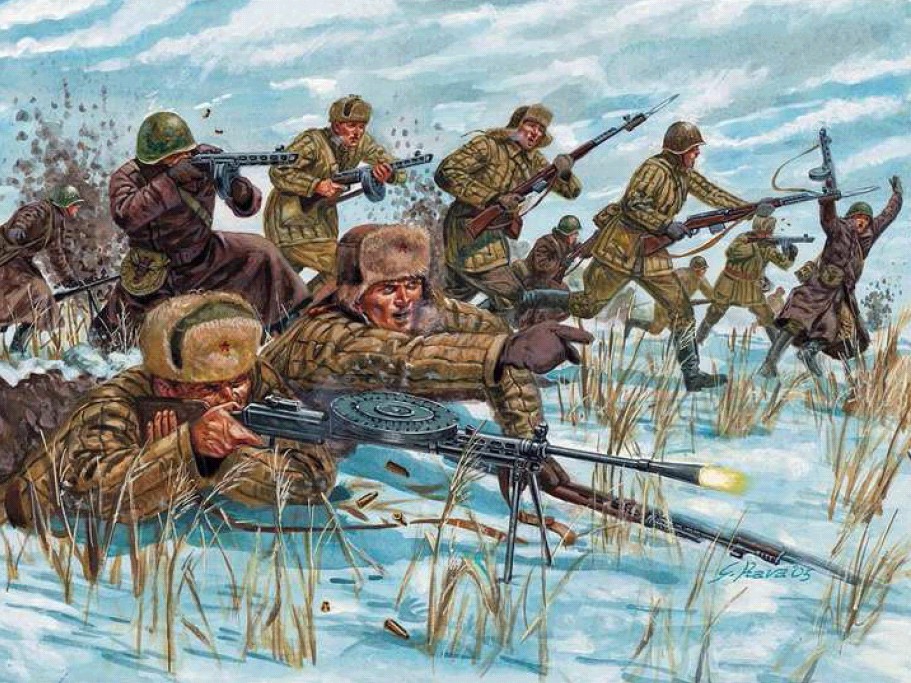
Notice WW2 Russian Infantry Had DRUMS for their automatic weapons to gain suppressive fire dominance
An Army Colonel writes a 2003 Report from Iraq:
"Everybody needs two weapons. Forget M4s. They don't get enough muzzle velocity generated to go through cinderblocks but M16s do. We need to rethink small caliber for combat in cities. Need something that kills the close in target not pokes little holes in it. Something like a Thompson submachine gun with a little more powder behind it.
MWG 90-Rounder Drum for M16/M4s...
 youtube.com/view_play_list?p=B44EA0F3F96548BF
youtube.com/view_play_list?p=B44EA0F3F96548BF
 youtube.com/watch?v=CEF8iNtpbmw
youtube.com/watch?v=CEF8iNtpbmw
 youtube.com/watch?v=9iqHlHBq-0o
youtube.com/watch?v=9iqHlHBq-0o
Need to re-look night vision for semi-illuminated urban environments.
Everyone loves the .50 cal. Need to re-look the TO&E of motorized and transport units so they are more like WWI in the number of machineguns. Every truck in your unit needs a ring mount and a fifty up front and probably another in back.
Fire extinguishers need to be able to put out big rubber and fuel fires. 240 Machine guns get great reviews but not enough of them.
SAWs are great but poke little holes. They are used as crew-served weapons a lot on HUMMVEEs without something bigger.
All units need to work on machinegun marksmanship.
Sniper training in urban environment where people are living and moving around your position needs a relook.
Need rubber pads for guard posts; lots of standing for troops."
The American rifle squad is notoriously outgunned by most enemies with Rocket Propelled Grenades (RPGs) in close fights where its rapid-firing explosive effects trump the garden hose effects of bullets; think Mogadishu and now Afghanistan. I don't know about you, but I'm sick and tired of this sorry state of affairs. The RPG has two pistol grips and a dedicated gunner so it can be run into firing position, ready-to-shoot whereas U.S. disposable rockets are ignored without a designated gunner and have to be opened to fire, precious seconds we can ill afford in a firefight. The first fix we need is a bullet-trap combination rifle/hand grenade that can be supplied to EVERY Soldier in the rifle squad to project a grenade out to 150 meters. To save weight, it could also be tossed like a German stick grenade so most hand grenades wouldn't have to be carried. Our disposable SMAW-D (M141) and AT4 (M136) rocket launchers should have pistol grips molded into them so we can run-and-shoot like the enemy's RPGs. Next, we should purchase M3 Ranger Anti-Armor Assault Weapon Systems (RAAWS) which the 75th Ranger Regiment uses, but are actually Carl Gustav 84mm rocket launchers the rest of the world has used for decades for out to 700 meter explosive shock action and supply them to the weapons squad in every rifle platoon and a designated gunner and ammo bearer. FYI, the AT4 shoots a Carl Gustav 84mm rocket from a disposable launcher, the SMAW-D shoots a Mk-153 SMAW 83mm rocket from a disposable launcher. The Mk-153 SMAW is a re-loadable rocket launcher used by the USMC but lacks the huge family of rounds that the Carl Gustav has available for versatility, but does have a clever spotting rifle aiming system. See things for what they are.
Former marine officer, Carlton Meyer writes that we need even more firepower for urban combat success:
"I agree we shouldn't reconfigure infantry for the remote chance of more mountain warfare, but I don't see jungle warfare in the future either; it will be 90% urban warfare (as a percent of casualties). The big issue is
However, I agree that leaping to a new cartridge is a big step. I agree with the marine corps idea for one or two sharpshooters per squad, but I'd arm them with a .338 or an extra-light .50 cal. Not only for body armor, but doors, walls, cars, And yes,
Each squad would have two light 5.56mm rifle maneuver fire teams, and one weapons team with a 7.62mm MG, an RPG, and an extra-light .50 rifle"
Carlton is right---we need to make DRASTIC changes to prevail in MOUT. The Army rifle squad has 2 x 4-man fireteams. I'd put a .50 caliber sniper weapon in the weapons squad at platoon level for starters. The belt-fed 5.56mm M249 LMGs have been disappointments in my opinion--jam if you fire 30 round M16 magazines through them, noisy....me thinks a heavy barrel M16 with a bipod and multiple connected magazine set-up or a CMAG type drum (that works) would be lighter and better as a real BAR type replacement. A BAR needs to be able to be fed by the ammo from the riflemen instantly. So why not cut out a couple weak M249 LMGs in the Army rifle squad and replace with a heavy barrel M16 or a 7.62mm LMG or .50 caliber sniper weapon system?
Future U.S. Army Rifle Platoon configured for MOUT Version 1.0
PL (7.62mm M16A5)
PSG (7.62mm M16A5)
RTO (5.56mm M4)
1st Squad
2nd Squad
Details:
3rd Squad Leader (7.62mm M16A5)
Team leader A (7.62mm M16A5)
Rifleman/Scout (7.62mm M16A5)
Grenadier (OICW 20mm GL, 5.56mm M4)
Automatic rifleman (5.56mm HB M16A4 LMG with bipod)
Team leader B (7.62mm M16A5)
Rifleman/Scout (7.62mm M16A5)
Grenadier (OICW 20mm GL, 5.56mm M4)
Automatic rifleman (5.56mm HB M16A4 LMG with bipod)
Weapons Squad @ Platoon level
Medium Machine Gun Team (7.62mm LW M240B MMG)
* ALL have
Rationale: the "movers" have 7.62mm M16A5s to point/shoot, knocking down targets as they pop up. The "suppressers" have 5.56mm M4 carbines shooting smaller bullets in quantity to fire over time so the "movers" can, move.
A former Army SF grunt and now AF special operator writes:
"I have some issue with the 'M16A5'.
Besides the fact that I don't think we need to outfit almost every guy in a squad with a 7.62 weapon, we are going to have a major problem with the logistics tail if we call the 7.62 black rifle variant an M-16. I like the Knight's weapon and one of those per squad is a great idea. In MOUT you are going to need a lot of bullets and they aren't going to be going very far so you might as well stick with 5.56. The M-4 with SOPMOD is the best weapon I have ever used. Granted, I only have 17 years of military experience. If you asked my dad, there is no finer rifle than the [7.62mm] M-14.
Perhaps SOCOM will get it right with the SOF Combat Rifle (Light) coming in two calibers. If it works, hopefully we will see it spill over to the rest of the Army and we will have one rifle consisting of one lower and two uppers (maybe three). I say three because there are two companies coming out with .50 uppers that fit the M-16 family. I can see a place for those in the inventory as well.
Stick with the SAW. The Rangers and SEALs (Mk 46) both have lightweight variants that work very well. The M-240 (MAG 58) is also a great weapon and it is one of the many things we have gotten right in regards to small arms in the past ten years.
I don't think the problem is necessarily with the weapons we currently have in the inventory. We have found that we need to supplement them with additional capabilities to help us deal with different environments we will encounter.
You have got to clear buildings, room by room and that is going to take a lot of bullets. 5.56 is lighter than 7.62 hence, you get more of the smaller bullets = more rooms. At the ranges we are talking the 5.56 will do the job. I maintain that almost everyone in the squad needs a 5.56 weapon. Add a sniper in each squad with a Mk 11. And then give the .50 uppers to two of the guys for use when METT-T requires it. Our guys need a tool kit and the M-16 family is a great platform to base that tool kit on. You add to it an M-203 with a new family of rounds and you will kick some butt. I am talking about things like an insert so you can use shotgun rounds.
I wouldn't even bother with OICW. I would develop a [smart, air-bursting] 40MM round and a 203 variant to employ it. I remember reading that there is something in the works.
Of course, I still think we need a telescoping, bullet-thru rifle grenade that can be employed by hand as well. Then EVERY man is a de-facto grenadier."
Future U.S. Army Rifle Platoon configured for MOUT Version 2.0
PL (5.56mm M4)
1st Squad
Details:
3rd Squad Leader (5.56mm M4)
Team leader A (5.56mm M4)
Team leader B (5.56mm M4)
Weapons Squad @ Platoon level
Assault Rocket Team (M3 RAAWS 84mm Carl Gustav)
Heavy Sniper Team (.50 caliber SWS)
* ALL wear rifle caliber resistant body armor to include gunshields on their weapons
* Some have SMAW-D rockets with pistol grips
* Organic All-Terrain All-purpose Carts (ATACs) and electric/pedal All/Extreme Terrain Bikes (A/ETBs) to enhance mobility
PSG (5.56mm M4)
RTO (5.56mm M4)
2nd Squad
Designated Sharpshooter (7.62mm "M16A5" or "Mk11" or "SR-25")
Rifleman/Scout (5.56mm M4)
Grenadier (5.56mm M4 with "smart" 40mm GL)
Automatic rifleman (5.56mm M249 LMG with bipod)
Rifleman/Scout (5.56mm M4)
Grenadier (5.56mm M4 with "smart" 40mm GL)
Automatic rifleman (5.56mm M249 LMG with bipod)
Medium Machine Gun Team (7.62mm M240B MMG)
* ALL have
7.62mm is no panacea for Mountain Combats
Phil West and a former Army enlisted Ranger and Army officer observe:
"By 1945 the Germans had the tools they wanted for infantry, and considerable experience knowing what worked.
The best equipped squads would have one or two MG42s [
Second historical thing
The idea of intermediate rounds (optimised for 500m or less) was a German wartime concept. The usual explanation you see is that in most of the world visibility prevents shooting at more than this range. Since MGs and snipers routinely shoot at greater ranges, the accepted explanation is obviously wrong!
By 1942 the German Army was very familiar with alpine and desert fighting-and it is very 'un-german' that these would not have been figured into development of the intermediate rounds. My theory is this. It is accuracy not visibility that is the limiting factor.
A 7.92mm or lesser bullet takes around a second to reach 600m. In that time an aware target can sprint 5-9m -you don't know which direction he will take, and he'll often be darting between cover. Your chance of hitting him with a single-aimed shot is virtually random. I think most shooting was less than 500m because most german riflemen knew there was little point shooting beyond this unless the foe didn't know you were there or you could fill an area of about 10m with bullets.
A couple of friends confirm this with more recent experiences:-
Friend A
'DOD did the same kinds of studies for all kinds of terrain, same result/conclusions; usual infantry engagement was 300 yards or less (didn't matter what you were armed with, typical infantry could not get hits at greater than 300m unless shooting volleys in mass or using machineguns. I was a former USMC National Match M-14 shooter and I can testify that even then the average infantryman was not going to get hits beyond 300m.) If you are under 1000m you call company or
Friend B
'If you sight a target element that far away it is much more tactically feasible to call in artillery fire or an air strike thus saving
I used to advocate that mountain units should be issued 7.62mm rifles like the FAL for 'more range' -but now I begin to rethink. If you are not shooting at 1000m, a 20-24" barreled M16 is less of a burden to carry up the mountain.
The 7x45mm sabot round would solve performance -more carrying power, better terminal effects and less effected by cross winds.
On the 5.56mm -best terminal effects are when the round fragments -for both the M193 and the M855 this is at less than 200m for a M16, 150m for a M4 and does not occur when fired from barrels under 14.5" -so how much use for defence is that 10" under the OICW? A smart fused 40mm grenade for the SACO Striker GMG already exists -with a reduced charge this should work in the M203 etc. As said, the AR15 is modular-you can change a M4 to a M16 by just drifting out a pin and changing the barrel and receiver top -no need to provide both M4s and M16s for every trooper"
Assault Rocket Team (M3 RAAWS 84mm Carl Gustav)
Heavy Sniper Team (.50 caliber M16-based SWS)
* ALL wear rifle caliber resistant body armor to include gunshields on their weapons
* Some have SMAW-D rockets with pistol grips
* Organic All-Terrain All-purpose Carts (ATACs) and electric/pedal All/Extreme Terrain Bikes (A/ETBs) to enhance mobility
We must still realize even after doing all this, that many 7.62mm snipers in Afghanistan now want .50 caliber rifles for 2 km range---even 7.62mm for 1 KM range isn't enough to hit many targets. Remember, this is the mountains and enemies can be seen farther away than can be hit with small caliber arms. The epic Canadian sniper team exploits killing al Queda terrorists were only possible by the range of their .50 caliber rifles. In some fights other, heavier weapons will have to be central to the fight--in deserts its Anti-Tank Guided Missiles (ATGMs) since you can't walk far in the desert and ground vehicles are the main movers and targets, in mountains its long-ranged mortars, artillery, rockets and heavy machine guns---learn to value these weapons and not be rifle and ego-centric; rifle infantry is to MANEUVER, to locate and close with the enemy, these are not idle thoughts. For infantry to move, other weapons will have to suppress and we would be wise to also field towed 2.75" Hydra-70mm rocket launchers, and integrate C-130 airdrop and airland transportable M113A3 Gavin light tracked Armored Fighting Vehicles into Army Light and Airborne units since they weigh 10.5 tons--the same as their FMTV 5-ton trucks yet provide tracked armored mobility and 25-30mm autocannon, 120mm heavy mortar firepower to reach out across open terrains or bust through urban structures and destroy enemies so the infantry squad can arrive to encircle and destroy the enemy who cannot escape. The Army has a M113A3 Gavin unit on alert in Germany to fly into Afghanistan, but doing this would reveal to the world that there is no need for lav3stryker rubber-tired armored car multi-billion-dollar purchases. Air Assault infantry can achieve similar Air-Mech-Strike capabilities with 7-ton armored M973A2 Small Unit Support Vehicles (BV-206S in NATO terms) or Miniaturized M113 that can roll-on/roll-off CH-47D Chinook helicopters.
Noted war futurist Phil West of England concludes:
"For a squad/platoon marksman rifle my inclination is for something that can hit harder at long range than the 5.56mm weapons. In fact I'd like something harder hitting than the 7.62mm LMGs too. The British Army seems to feel the same since they are arming platoon snipers with .338s.
Best candidate is a magazine bolt-action in either .500 Whisper or .510 Whisper. Both rounds are from SSK and use .50 BMG bullets, the former in .460 casings, the latter in .338.
With modern synthetics it should be possible to create a weapon of 12lbs or less. If you are moulding a stock it only makes sense to make it in a mottled grey and brown pattern, or even Advantage.
Using a .50 rifle gives the options of
ˇ Subsonic rounds.
The fact that these rounds use the same bullets as .50 BMG weapons means that rounds developed for .50 weapons can be easily adapted to the rounds.
Which ever round is chosen, be it the .500 whisper or .510 Whisper a new name will be needed for military use to avoid confusion. I suggest '.510 Sniper' or '.510 SSK'. 'Five-ten' cannot be confused with 'fifty calibre', and dropping the term Whisper prevents the weapons being though of as 'specialized'.
Extended range sniper weapon. I think this should stay .50 BMG. Best choice seems to be the Ferret 50, which is in use in
I've suggested that the Ferret have an ejector added to increase rate of fire against targets such as vehicles or helicopters. I've also noted that a integral side feeding magazine could be incorporated. Another feature worth looking into is a blast suppressor.
ˇ Large capacity anti-material rounds such as HEI.
ˇ High penetration rounds such as SLAP
ˇ Sabotted high velocity long range rounds in .338 or .408
www.angelfire.com/art/enchanter/hush.html
The Finns have built these for weapons such as the Barrett. Not only do these reduce blast, noise, flash and dust kick-up, but also recoil. The sabotted .338 or .408 rounds suggested above could also be mounted in .50 BMG cases.
As far as assault rifles and other armaments go, my views are summarised at
In closing, if we discard the M16/M4 family and waste millions of dollars reinventing the assault rifle and grenade launcher----that would be better used to gain new capabilities like bullet-trap rifle/hand grenades and better rocket launchers---instead of optimizing them, we will lose a golden opportunity to exploit their modularity to attain both open and close terrain combat dominance on the 21st Century battlefield.
What About Snipers?
Women actually have a steadier aim than men; but who wants them in a war zone?
Well of course, if the sexy Russian lady comes with the sniper rifle, we must have one added to each 9-man Infantry Squad, making it a 10-person Squad!
Sadly, back to reality.
Should at least one Soldier in every infantry squad be a school-trained sniper from the Fort Benning, Georgia school or equivalent?
YES.
Who should he be and what weapon should he carry?

The Russian Army has some positive points...
If we go with the M16A5 concept, the sniper-trained Soldier would be in 7.62mm configuration and have a powered ACOG optic as well as a Red Docter red dot reflex sight. WHERE should he be in the squad?
The rifle squad DESIGNATED TO BE THE BASE OF OR SUPPORT-BY-FIRE ELEMENT where everyone shoots 7.62mm x 51mm NATO from their M16A5s would be where the "sniper" operates in the classic mode. Could the school-trained snipers in the maneuvering squads in 5.56mm M16A5s act as a designated marksman? Possibly. Realizing he would be the only one in 7.62mm he could shoot a bit farther to help his maneuvering squad albeit if he needs ammo he only has the squad's 7.62mm LMGer to possibly share with him. If the Platoon Leader or Squad Leader want him in 5.56mm like the rest of the maneuvering squad, then of course he shoots the same ammo like everyone else--but with implied greater skill levels. At some point Soldiers need to become professionals and take the mission on as their own and employ their full intellect to make real decisions about how their work. We TALK all this hypocritical crap about "small units being decisive" and "empowerment", it's time to put up the equipment with which to DO IT.
What About Anti-Tank (AKA Anti-Materiel) Rifles?
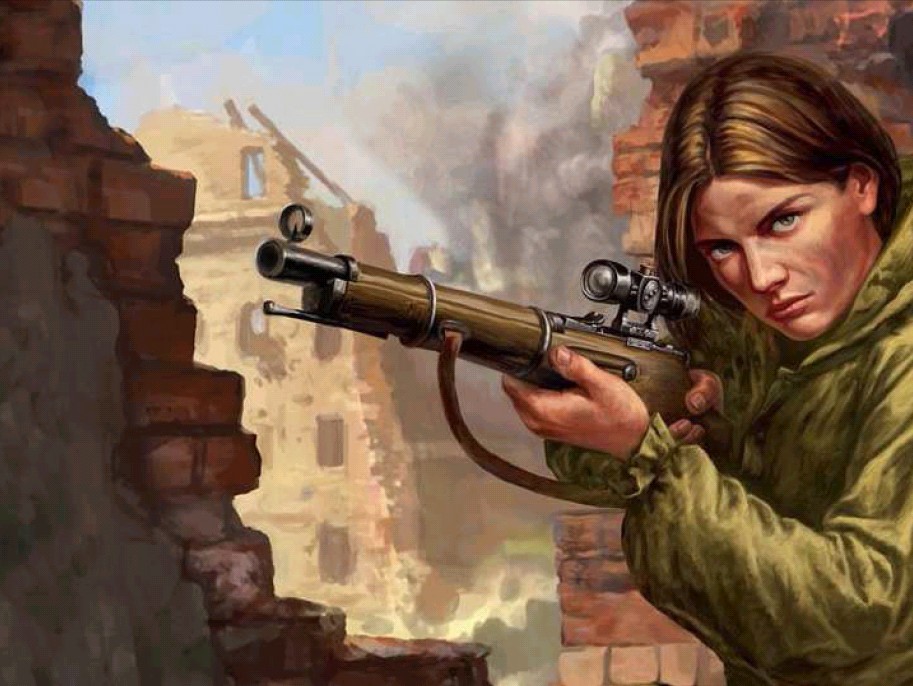
The Barrett M107 .50 caliber (12.7mm) AT Rifle: 32 Pounds
The Anti-Tank (AT) rifle is a curious weapon that is constantly being disparaged by Type B personality tanksters as not being able to penetrate their ever heavier armor as they hide in bigger and less mobile tanks. Yet, if AT rifles were so worthless, why did every British Universal Carrier come with a .55 caliber Boys AT rifle? Why did SOE use ubersexy spy Krystyna Skarbek to sneak out the top secret Polish lightweight, high-velocity WZ.35 7.92mm AT rifle? Why did the Germans copy the concept and utilized their own AT rifles until war's end?
combatreform.org/tankterror.htm
Moreover, if AT rifles were too heavy to carry for their worthless effects why did the Germans add stand-off armor plates to their tanks to defeat their effects? OOPS! The MechPs are caught in another one of their lies!
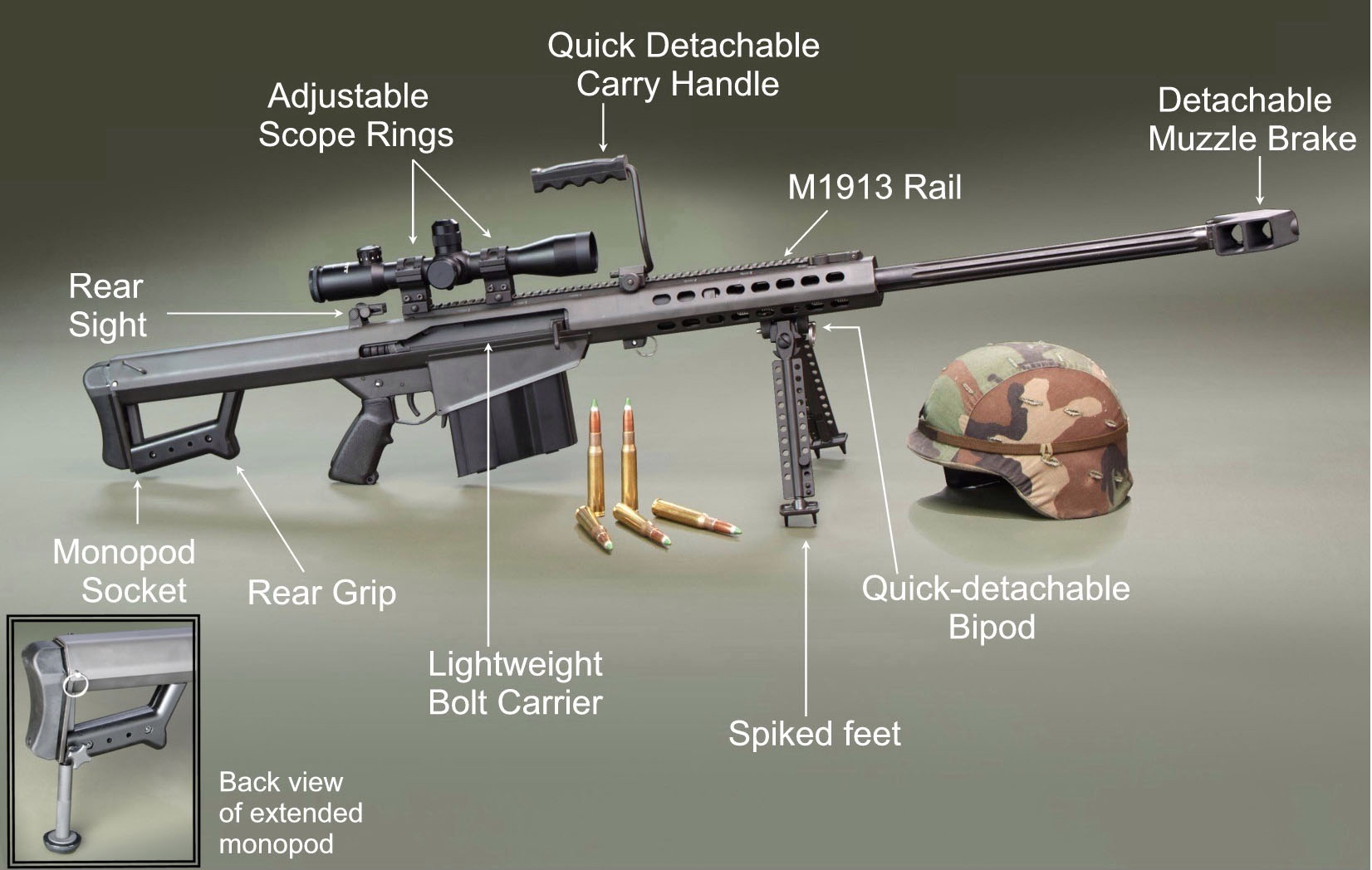
From Osprey's German Tanks of World War II in Color, page 36.
Obviously, AT rifles ARE valuable in land combat be it against tanks or trucks or troops hiding behind cover. Don't listen to Type B personalities when it comes to fighting harder. Wanting to fight easier, their laziness might offer efficient means. Of course, LIGHT INFANTRY should have LIGHT TANKS. Even the cash-strapped British in WW2 had Bren gun/Universal Carriers. Nevertheless, the infantry PLATOON should have at least one AT rifle. However, at 32 pounds, the current gas-operated Barrett M107 at 32 pounds is too heavy to carry. Even their bolt-action model is too heavy. However, by taking advantage of the M16A5 lower receiver infantry already has, a .50 caliber or 20mm or 30mm shooting upper receiver could be spliced together to offer the capability. The M16A5 AT upper receiver module would be heavy--but only on the 10 pounds order of magnitude and would be carried IN THE INFANTRY'S VEHICLES until needed. If needed for dismounted action, the sniper-trained Soldier in the SBF/BOF element would CARRY and employ the M16A5 AT Rifle to gain the heavy bullet or high explosive shell effects we now currently lack--and have lacked ever since we retired the 37mm AT gun at the end of WW2. There needs to be a way to foot-maneuver and shoot heavy bullets/HE shells from a bolt-action short of having to crew-serve a heavy machine gun or a heavy gas-operated AT rifle in deliberate bounds.
Candidate .50 caliber M16A5 AT/AM Rifle "The Ferret"
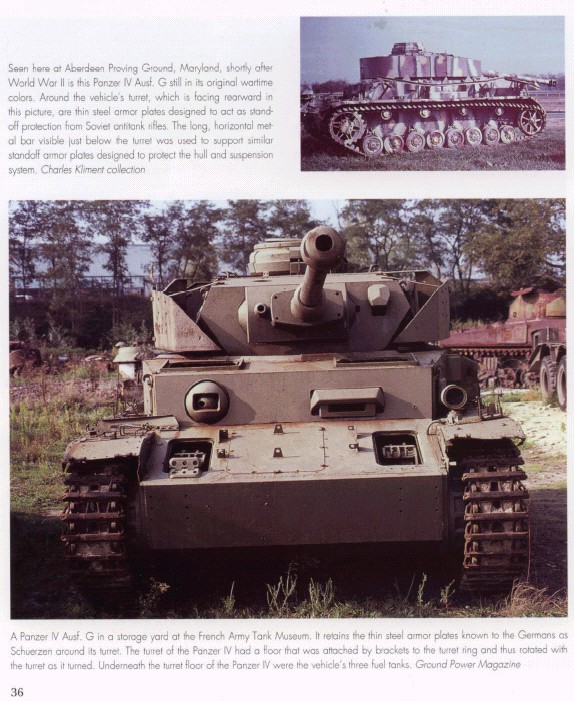


Barrel weight could be saved by fluting to make a M16A5 AT-AM Rifle Option Even More Attractive
Dave Moore
Spider Firearms
2005-B Murcott Dr.
St. Cloud, Fl 34771
(407) 957-3617
.50 Caliber Suppressors: Possible and Necessary!
Another aspect of the M16A5 AT-AM Rifle is that it should have a suppressor to hide its flash and its sound source. There are several models available off-the-shelf. A market survey is below.
www.autoweapons.com/photos06/sep/82cqsup.html
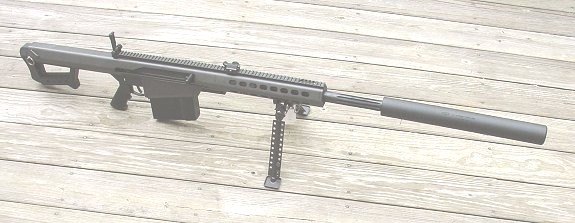

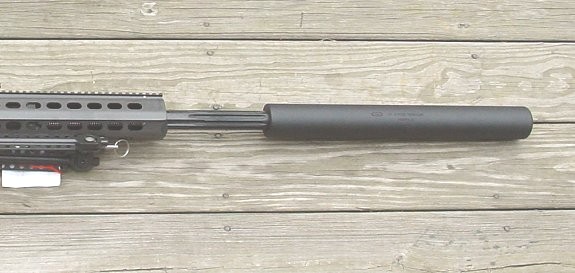
Armament Service International
Corporate Headquarters:
103 Camars Drive, Warminster, PA 18974
P.O. Box 226
Richboro, PA 18954
(215) 293-0200
FAX (215) 942-4136
info@autoweapons.com
www.class3weapons.com/AWC_Turbodyne_50_Suppressor_p/turbodyne50.htm

The AWC TURBODYNE (TM) is the most effective, compact .50 caliber suppressor available. The TURBODYNE offers extreme recoil reduction - more effective than any muzzle brake design and Eliminates the need for shooters, observers or spotters to wear hearing protection. The TURBODYNE is removable and mounts to muzzle brake threads and can be fitted to most .50 caliber rifles. The TURBODYNE is custom fabricated to your weapon system and mission requirements and can be finished in a variety of standard or camouflage finishes.
O. A. Length: Varies by design
Diameter: 2. in.
Weight: Varies by design
Construction: 100% Stainless Steel
Finish: Matte Black, Matte Stainless
Threading: Varies by design
www.precisionweapons.com/cartgenie/prod-94.htm

Gemtech Stormfront .50 Suppressor for Barrett M107
Designed specifically for the .50 caliber Barrett models 82 and M107 rifles, the STORMFRONT features a 2-point mounting system for increased stability and safety. It has redundant safety features while retaining a light weight. Flash and visual (dust) signature is almost completely done away with.
The STORMFRONT reduces sound levels more than 10 decibels below the bullet flight noise. At the shooter's ear, it meets the European requirements for shooting without hearing protection. Currently available only to U.S.
DRM
P.O. Box 704
Waxahachie, TX 75168-0704
Toll free: 888-DRM-GUNS (888-376-4867)
Office Phone: (972) 937-6886
Fax: (972) 923-0298
Hours: 9-5 M-F (closed Sat/Sun)
PDW Rifles For Aircrews: the STReamlined to-the-Body Aircraft Escape Weapon (STREAM-BE)

Crash & Defend
The most famous downed Aircrewmen defending himself from being over-run by the enemy is CWO2 Michael Durant, who during the famous Blackhawk Down! (BHD) incident on October 3, 1993 was stuck inside his downed aircraft. Armed with both a 9mm MP5 sub-machine gun in his aircraft and a M9 Beretta 9mm pistol in a holster close to his body, he was assisted by two Delta operatives Shughart & Gordon who fast roped down from another helicopter and held off the enemy for a short time before they were killed--and Durant himself ran out of ammunition. Durant was captured by the enemy and after the U.S. government told them to release him "or else", he was safely returned to home.
We Should Have Figured this Out Starting with WW2
WW2 combat had shown that infantry needs more than rifles that can reach out across open areas (long-range battle or "LRB" out to 1, 000 meters) that usually meant bolt-actions firing powerful cartridges. Once the stalemate of trench warfare was broken, maneuvering elements could bump into each other at short (SRB--less than 300 meters) and close quarters (CQB--less than 50 meters) range battle distances requiring faster-firing weapons. At first, to get faster-firing weapons pistols and sub-machine guns shooting small pistol cartridges were used--but these lacked range for SRB and LRB firefights. Hence the eventual creation of the assault rifle (AR) shooting a scaled-down rifle cartridge.
Another negative example of pistol and pistol ammunition failure on the open battlefield is the 1949 abduction and murder of U.S. Army Captain/OSS Operative/Missionary John Birch and his group--not constrained by aircraft limitations in regards to the weapons they could carry--at the hands of the Chinese Communist (CHICOMs).
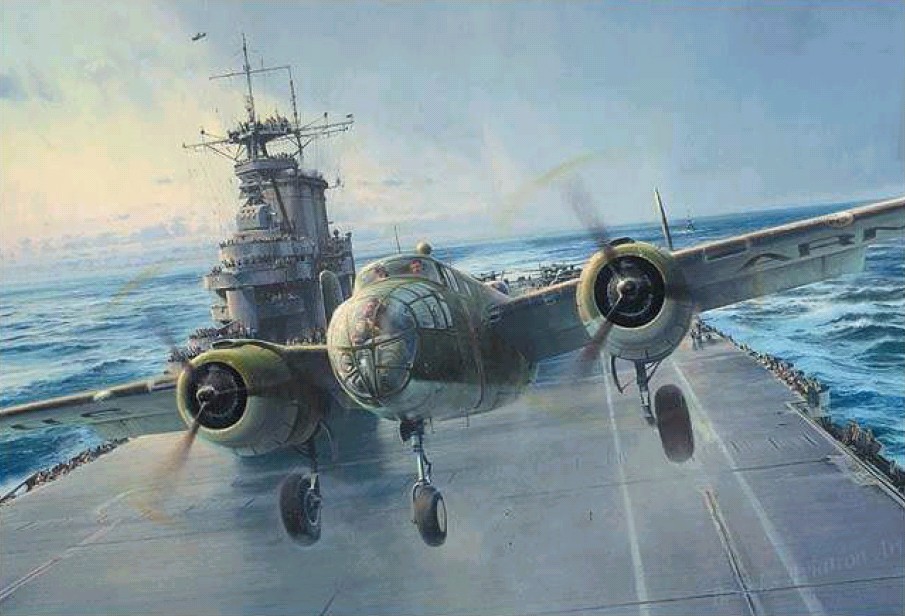
Doolittle's Raiders Had to Strip-Down their B-25s in Order Make it to Japan...how much if any Personal Weapons did the Aircrews carry?
It's ironic since Birch helped rescue Colonel Doolittle's crew after they bailed out from their raid on Japan. I wonder what if any personal weapons they carried since they were so pressed to save weight for fuel their turret guns in some cases were broomsticks painted black!
http://en.wikipedia.org/wiki/John_Birch_(missionary)
When Doolittle arrived in Chongqing, he told Colonel Claire Chennault, leader of the Flying Tigers, about Birch and his help. Chennault said he could use a Chinese-speaking American who knew the country well. Chennault commissioned Birch as a 1st Lt., although Birch said in a book[which?] later that he was willing to be put in as a private.[citation needed]Birch joined the Fourteenth Air Force on its formation in 1942 and was later seconded to the U.S. Office of Strategic Services (OSS). He stated he would be willing to be accepted into the OSS only if he was allowed to work as normally as he had before. He built a formidable intelligence network of sympathetic Chinese informants, supplying Chennault with information on Japanese troop movements and shipping, often performing dangerous incognito field assignments, during which he would brazenly hold Sunday church services for Chinese Christians. In his diary, Maj. Gustav Krause, commanding officer of the base, noted: "Birch is a good officer, but I'm afraid is too brash and may run into trouble." Urged to take a leave of absence, he refused, telling Chennault he would not quit China "until the last Jap" did; he was equally contemptuous of Communists. He was promoted to Captain and received the Legion of Merit in 1944.[1]
V-J Day, August 14, 1945, signaled the end of formal hostilities; but, under terms of the Japanese surrender, the Japanese Army was ordered to continue occupying areas it controlled until they could hand power over to the Nationalist government, even in places where the Communist-led government had been the de facto state for a decade. This led to continued fighting as the People's Liberation Army fought to expel all imperial forces, a category it perceived to include U.S. personnel now openly collaborating with the remaining Japanese forces. On August 25, as Birch was leading a party of Americans, Chinese Nationalists, and Koreans on a mission to reach Allied personnel in a Japanese prison camp, they were stopped by Chinese Communists near Xi'an. Birch was asked to surrender his revolver; he refused and harsh words and insults were exchanged. Birch was shot and killed; a Chinese Nationalist colleague was also shot and wounded but survived. The rest of the party was imprisoned but released shortly. Birch was posthumously awarded a Distinguished Service Medal.
Another version:
military.com/Content/MoreContent?file=ML_birch_bkp
Both in Chungking proper and in the interior, Birch used his language skills and analytical talents to draw up a network for the China Air Task Force, which replaced the American Volunteer Group. By all accounts, Birch was a man of great skill and even greater modesty; when he was awarded the Legion of Merit in 1944, he wrote to his mother, "they ought not to cheapen the decoration by giving it when a man merely does his duty." By war's end, Birch had achieved the rank of captain and his duties had come under the spreading auspices of the Office of Strategic Services (OSS). [EDITOR: the AmeroNazis stopped this by disbanding the OSS in 1945, blinding us of intel as China collapsed into Communist control]Shortly after the war ended, Birch and a party of 11 Chinese were sent by the OSS to accept the surrender of a Japanese base. On Aug. 25, 1945, they met a group of Chinese communists who refused to allow them to pass. They disarmed Birch, and shot his aide Lt. Tung when he tried to intervene (Tung lived to tell the tale of Birch's treatment). Birch's ankles were bound and he was made to kneel for execution, then shot in the back of his head. Birch, who had spent the war working behind enemy lines to serve both God and country, is considered by many to be the first casualty of the Cold War.
Detailed Analysis: Did Weak Infantry Weaponry & Tactics Result in the Loss Not Only of Birch, But China to Communism?
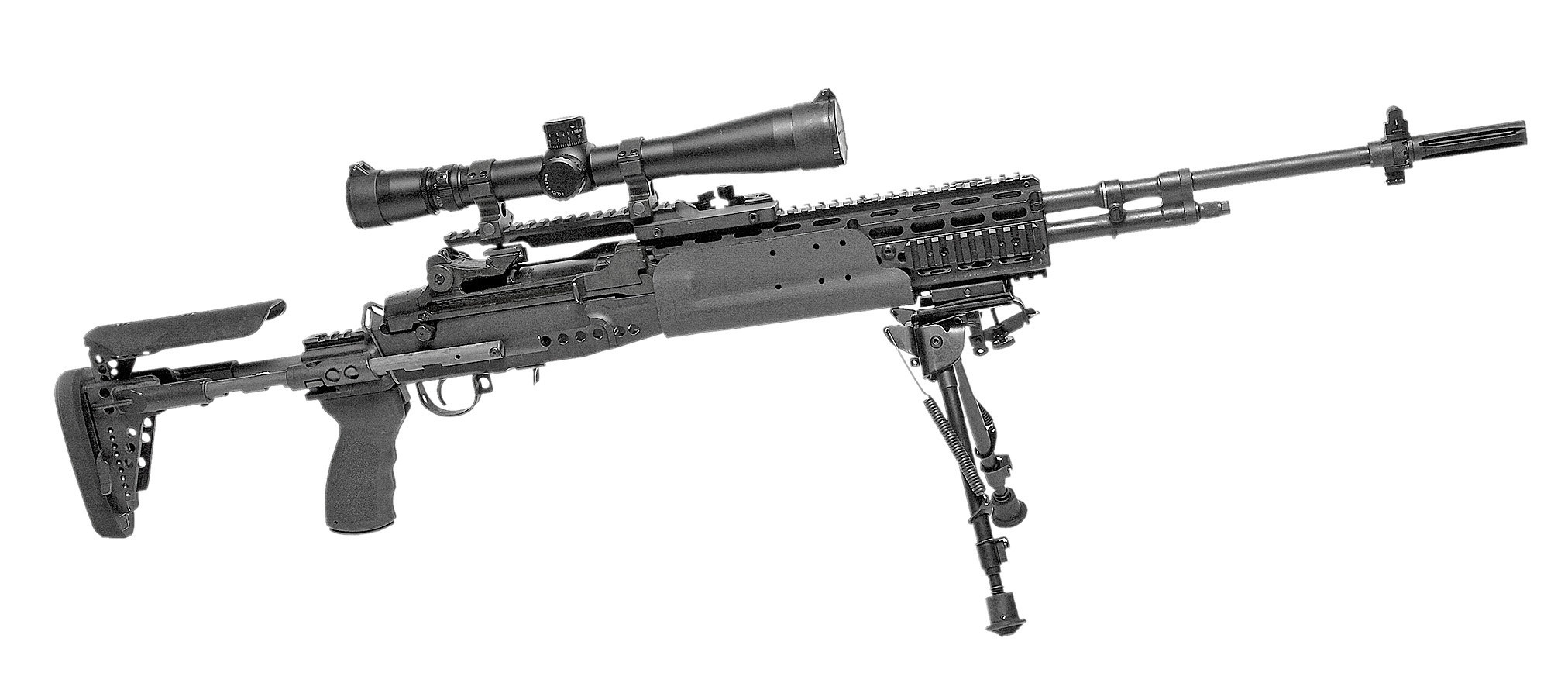
I bet had Birch and his 11 had M1 Garands with 20-round magazines and pistol grips (defacto AKA assault rifles) even if confronted with a 100 commies the seizure wouldn't have happened. Pistols stink in open area combat. However, all 11 probably had bolt-action rifles that cannot fire fast to prevail in a close quarters battle (CQB) situation, either. If you have to carry weapons concealed, a pistol beats nothing. If you have to carry--and concealment is not a factor because you have to use your weapon(s)--make sure you can WIN with what you got. There is a middle ground between concealed carry-sized weapons and outwardly carried weapons we discuss below for those who need to be able to escape aircraft crashes; however Birch was in the middle of a war and could and should have had the absolute most powerful weapons on his party. The Commies seem to understand the need for fast-firing weapons with big magazines.
The weakness of the Nationalist Army on the ground for maneuver under General Stilwell in favor of backing Chennault in the air--emanating from Washington--resulted in China falling to Communist control. We should have sent enlightened advisors to Chiang's KMT to counter-act Mao's guerrilla warfare tactics like USMC Colonel Evans F. Carlson who knew their TTP from personal experience. He had actually met Mao and the other commie leaders! Carlson could have transformed the KMT at a fireteam-level to be superior to the Japanese and later prevail over Mao--while being politically aligned with a free enterprise economy and democracy.
http://en.wikipedia.org/wiki/Marine_Raiders
http://en.wikipedia.org/wiki/Evans_Carlson
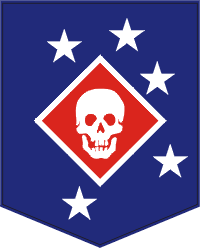

Notice his .45 caliber ACP in a cross-draw configuration with magazine pouch holding 2 x 7-round magazines. Colt .45s shoot the same stubby bullets as Thompson SMGs shoot...The Raiders were created by an order from President Franklin D. Roosevelt, acting on proposals from Colonel William J. Donovan [OSS founder with Commander Ian Fleming RNVR] and Major Evans F. Carlson. Carlson had been a Soldier in the Punitive Expedition to capture Pancho Villa in Mexico and World War I, became a marine officer during the American occupation of Nicaragua, and served as a Intelligence Officer of the 4th marines in China. He had seen the tactics and strategy of Communist Chinese irregulars, Zhu Dé and the Eighth Route Army in particular, as they fought the occupying Japanese and became enthralled with their version of guerrilla warfare.
A year later, in 1942, he was placed in command of the 2nd marine Raider Battalion with the rank of lieutenant colonel, a new combat organization whose creation he influenced. The organization and discipline of the 2nd Raiders was modeled on that of the Communist Armies he had observed during his time in China. Because of his relationship with President Roosevelt and the president's son, Captain James Roosevelt, a marine reserve captain who authored a letter to the Commandant of the marine corps proposing creation the Raiders, the marine corps authorized the creation of the Raiders despite misgivings about Carlson's philosophy.[1][2]
In the military there is a sharp caste-system divide between officers and enlisted personnel, and even experienced noncommissioned officers were expected to be subservient to even the newest, greenest second lieutenant. Carlson's experience in having gone back and forth between officer and enlisted status in both the Army and the marine corps convinced him that this was not in the best interests of the service. Carlson saw the Communist approach as superior. Leaders were expected to serve the unit and the fighters they led, not to be served. Responsibility, not privilege, would be the keyword for battalion leadership when the Second Raiders formed up. Using an egalitarian and team-building approach, Carlson promulgated a new way for senior NCOs to mentor junior officers and work with the officers for the betterment of the unit. Even more controversial in concept, Carlson gave his men "ethical indoctrination," designed to "give (his men) conviction through persuasion," describing for each man what he was fighting for and why.[2]
Of more lasting importance to the marine corps, Carlson also changed the organization of his squads, eschewing an eight-man squad dictated by the marines in favor of a 10-man squad composed of a squad leader and three 3-man "fireteams", each containing a BAR, a Thompson, and an M1 [Garand] rifle.[2]
EDITOR: notice here is the same big bullet/little bullet mix we are advocating for the M16A5 in WW2! Also note this is NOT the current BS USMC 13-man squad where the 3 x fireteam leaders are actually fireteam DIRECTORS looking constantly back to the squad leader for steering corrections. They are not adding firepower weight from their weapons and the pointman who is actually being guided off by the others is also compromised looking back at the fireteam DIRECTOR! The Carlson concept is also the Army's: the fireteam LEADER is someone who leads by example that the others emulate by moral influence and visuals. We have posted below the 1943 movie, "Gung-Ho" starring Randolph Scott cast because he looks exactly like Colonel Carlson for you to get a glimpse of how the USMC was supposed to be before the snobby bureaucrats corrupted the term to mean an uberlemming co-dependent. Suffice it to say, in my USMC enlisted and officer membership earning activities this movie was NOT shown; THINKING and EMPOWERMENT is NOT what HQMC wants. The uberBS lemming-for-the-bureaucracy movie, "The Sands of Iwo Jima" was shown to us ad nauseum.

 youtube.com/watch?v=PMBPsb6Euu4
youtube.com/watch?v=PMBPsb6Euu4
Carlson Had the Chinese Cultural and Tactical Skills to Save China from the Communists: Why didn't Donovan Snatch him up for OSS Duty? Or FDR to Help Stillwell?
The asshole and snobby HQMC disbanded the Raiders in 1944--if Carlson had nothing to do, why not send him to China to help Stilwell/KMT where his Chinese language and egalitarian leadership skills could really be of strategic influence? Or even promote him to a General and take-over from the abrasive Stillwell? We know that Carlson and Stilwell were even friends:

spartacus.schoolnet.co.uk/USAsmedleyA.htm
Smedley also became a close friends with Joseph Stilwell and Evans Carlson. Stilwell was commander of the United States Army in China whereas Carson was President Roosevelt's personal adviser in the country.
Why didn't Joe ask for Evans' help?
spartacus.schoolnet.co.uk/2WWstilwell.htm
(2) Evans Carlson wrote a letter to Agnes Smedley praising her for an article about Joseph Stilwell in the PM Magazine (5th November 1943)"It is good to have the spotlight turned on the true state of affairs inside China. Stilwell has done a magnificent job. I know of no other man who could have accomplished what he has in the face of all the obstacles out there. And while doing it he supported the highest ideals of American democracy and decency."
Smedley was the lover of Soviet Spy Richard Sorge who Commander Ian Fleming said was the greatest spy in history. Sorge had been the first to supply evidence to the west about the proposed attack on Pearl Harbour. He also learned that Japan would not attack Soviet forces in Manchuria unless Stalingrad fell--enabling Siberian divisions to be shifted to the west to defeat the Germans in the nick of time. Spartacus.net continues:
(3) General Alan Brooke, Chief of Imperial General Staff (diary entry, 15th June, 1944)"After lunch again the American COS, this time to discuss Burma. It is quite clear in listening to Marshall's arguments and questions that he has not even now grasped the true aspect of the Burma Campaign! After the meeting I approached him about the present Stilwell set up, suggesting that it was quite impossible for him to continue filling 3 jobs at the same time, necessitating him being in 3 different locations, namely: Deputy Supreme Commander, Commander Chinese Corps, and Chief of Staff to Chiang Kai-shek! Marshall flared up and said that Stilwell was a 'fighter' and that is why he wanted him there, as we had a set of commanders who had no fighting instincts! Namely Giffard, Peirse and Somerville, all of which according to him were soft and useless etc etc. I found it quite useless arguing with him."
The Nationalist Chinese Ground Army (KMT) was weak and couldn't evict the 1, 000, 000 Japanese soldiers from 1937-1945 so we order the Japs to hold China until the KMT could take their surrender and control of the area as a "stabilizing influence". Mao playing the "we hate-the-foreigners card" goes right back to my thesis that a VIABLE GOVERNMENT IN BEING (VGIB) is necessary for COIN to work otherwise, INsurgents will play the "foreign devil" card. Chiang/KMT could have reformed the land so the workers owned a majority of the land and its profits taking the wind from the Communists who were deliberately lying with unrealistic total peasant farm ownership.
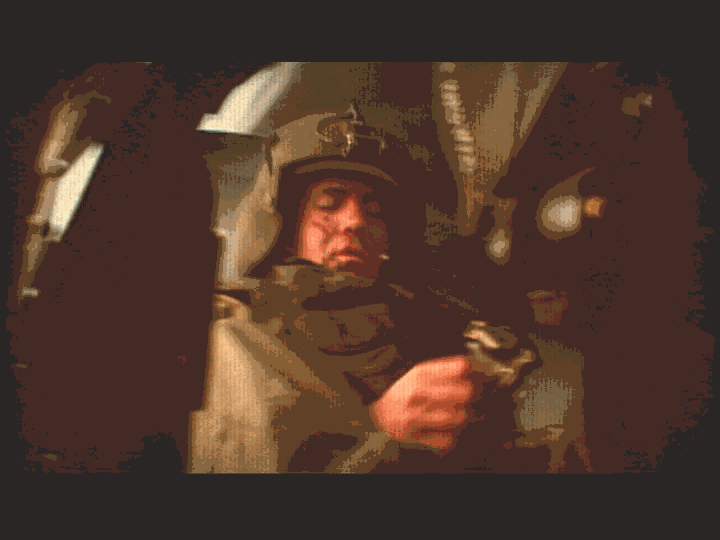
Today, Army aircrews carry more powerful, collapsible-stock M4 carbines that shoot .223 caliber (5.56mm x 45mm) cartridges in addition to their 9mm pistols on their bodies; but these can only be used if their aircraft crash doesn't end up being so severe that they must exit or die in a fire or they cannot leave their aircraft and/or the longer-barrel weapons get mangled in the wreckage. The long gun in an aircraft crash only becomes available if the crash leaves the airframe somewhat intact. Otherwise, the Aircrewmen who must bail-out, eject or walk/crawl away only has the weapon that's physically connected to his body. This weapon does NOT have to be concealed as there's no surprise in an aircraft crash. Later on, during escape & recovery (hopefully) the downed Aircrewmen might don civilian attire to hide at risk of being caught/shot as a spy and the weapon should be concealed. However, if the downed Aircrewman can't break contact with the enemy or keep from being captured or killed--nothing follows. First things, first.
Definition:
STReamlined to-the-Body Aircraft Escape Weapon: a personal defense weapon (PDW) hugging and conformal to your body to not impede escape from an aircraft crash/ejection/wreckage.
1993 Rationale:
Aircrewmen have a M9 pistol and a MP5 sub-machine gun (SMG) both shooting the same 9mm ammunition which they can share in a pinch. Sort of.
Re-Think:
Why carry a 5-poundish MP5 9mm SMG and a 3-poundish M9 Beretta pistol if the magazines are not inter-changeable? It's not enough of an advantage to shoot the same ammo if you have to load ammunition into mags in a fight where you are about to be over-run. Combat units that have armored vehicle shielding to have a safe area to pause between firefights and reload are not in the same desperate situation as downed Aircrewmen all by themselves without armor protection. For U.S. Army Special Operations Command to waste money buying MP5s that cannot shoot the same 9mm magazines of their pistols was ludicrous.
Wouldn't those 5 pounds of SMG or 3 pounds of pistol be better used to offer 45-75 rounds of ammunition to keep the enemy at bay if aircrews only had one weapon TYPE that can shoot the same magazines instead of two?
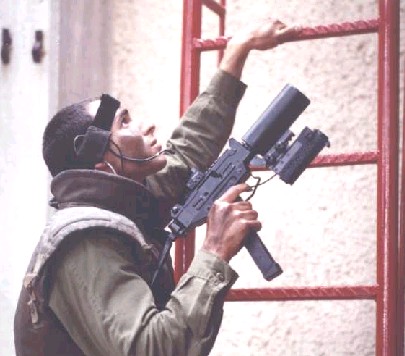
In stark contrast, the Israeli counter-terrorist unit YAMAM uses the Para Micro Uzi PDW/SMG that can also shoot their back-up Glock 17 pistol 9mm magazines:
http://files.uzitalk.com/reference/pages/micromain.htm
Why Sub-Optimize to Pistol Ammunition if your PDW Can Shoot Rifle Cartridges?
Today's Rationale:
Aircrewmen have a 9mm pistol on their body and a M4 5.56mm carbine in the aircraft with them because the weak pistol ammunition's smallness enables the weapon to be STREAMBE-sized and the best we can do to get a rifle cartridge weapon to them is have it in carbine-form in the aircraft--subject to myriad recovery problems.
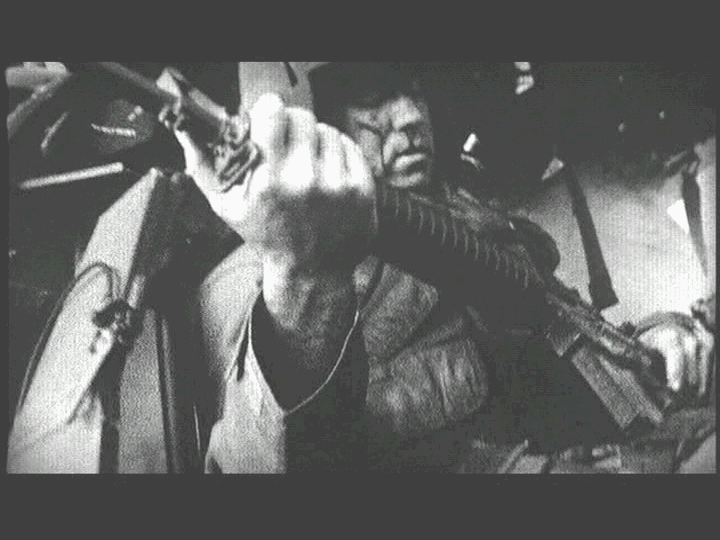
 scribd.com/doc/124678473/Personal-Defense-Weapon-Only-for-Defense-Walter-Balsavage
scribd.com/doc/124678473/Personal-Defense-Weapon-Only-for-Defense-Walter-Balsavage
Personal Defense Weapon Only for Defense? Walter Balsavage by
Re-Think:
Why carry 3-4 pounds of impotent 9mm pistol and two extra mags (45 shots) good out to only 25 meters as your STREMBE when you can have a 5.56mm PDW carried in the same body position and after unholstered, shoots out to 100 meters--using the same M4 carbine magazines--that possibly may also be used from their aircraft in event of a mild crash? If weight is a zero sum game, if the M4 carbine's 7 pounds were not carried, it could "pay for" 7 x 30 round magazines or 210 rounds of extra ammunition through the 5.56mm PDW to keep the enemy at bay longer--possibly enough for rescue. Certainly, each 30-round magazine carried is worth its weight in gold in terms of keeping the enemy away at a stand-off to facilitate rescue.
Another good idea would be for a small gunshield to be carried in the aircraft or in the ejection seat pack that could be attached to either the STREAMBE PDW or the M4 carbine to act as portable frontal cover:
combatreform.org/gunshield.htm
 scribd.com/doc/124678369/MAGPUL-s-PDR
scribd.com/doc/124678369/MAGPUL-s-PDR
MAGPUL's PDR by
STREAMBE 5.56mm PDW Candidates
Fly aircraft, possibly eject--or scramble away from a crash with 20-round magazine and have 30-round magazines in your survival vest to feed your STREAMBE PDW.
The weight of the 9mm pistol and 2 mags only offers 45 rounds to keep the enemy at bay at 4 pounds of weight---for roughly the same dimensional space on the body and close to the same weight as a CQB range pistol, one can have a SRB PDW and 120 shots that shoots the same ammo from the same magazines as the larger M4 carbine--if it can be recovered from the crash. If you can recover both, great; if you cannot, you are still able to use it's ammo that is more powerful than a pistol cartridge.
PLR-16

gunblast.com/Kel-Tec_PLR-16.htm
keltecweapons.com/our-guns/pistols/plr-16/
Kel-Tec CNC Industries, Inc.
P.O. Box 236009
Cocoa, Fl 32923
(321) 631-0068
Fax: 1169
keltecweapons.com
PDS
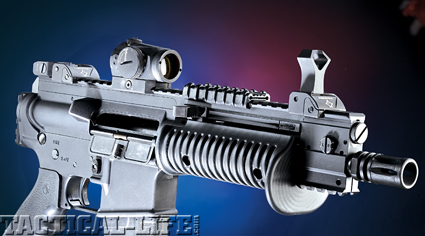
rockriverarms.com/index.cfm?fuseaction=category.display&category_id=441
Rock River Arms, Inc.
1042 Cleveland Road
Colona, IL 61241
(309) 792-5780
Fax: 5781
Toll Free: (866) 980-Rock (7625)
rockriverarms.com
Crash & Evade
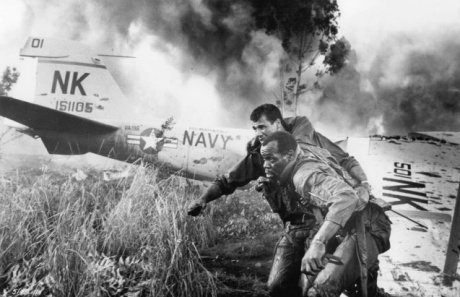
Often during the Vietnam war, it was not possibly due to parachute bail-out or ejection to be close to an aircraft crash site nor if it were possible, it would be unwise to stay put if the enemy was converging on you. Durant was stuck in his crash wreckage and couldn't move, so he had to defend himself from there. However, if Aircrew can eject/bail-out to escape the crash or have a somewhat mild crashland and stay able-bodied to evade both enemy detection and attack:
...their PDWs should be SILENCED to hide their muzzle flash and suppress their noise source so the enemy cannot easily locate them. In 1960, CIA pilot Francis Gary Powers parachuted from his sabotaged U-2 and had a silenced .22LR pistol in his survival gear.
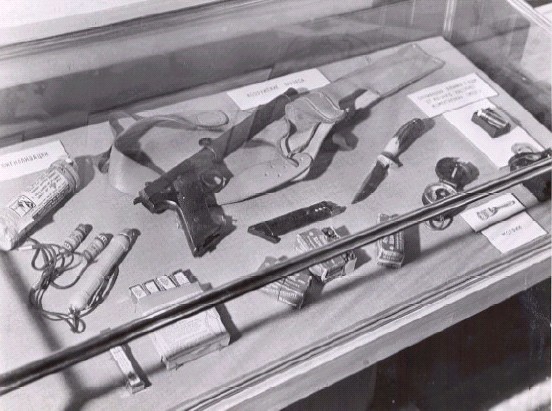
Either of the candidate PDWs listed above could be modified to accept a SureFire-type small suppressor to effect stealthy enemy elimination in a crash & evade scenario for the weight cost of about 1 x 30 round magazine.
Aircrew PDW History

The USAF was faced with the downed aircrew conundrum during the Vietnam war and sought a 5.56mm PDW that would be held in the seat pack of ejection seats. The Bushmaster Armpistol:
USAF Ejection Seat-Pack
www.biggerhammer.net/armpistol/variants.html
Unfortunately the USAF bureaucracy took the low road to aircrew defense and opted for a weak pistol that in the case of the 9mm Beretta offered the small improvement of 15 + 1 shots instead of the 7 +1 from the .45 ACP. In the previous discussion we ignored the "+1" in the chamber to simplify the issue, here it's important since every round counts when its got to be on the body. Add two magazines of 15 rounds each, and today's Aircrewmen can have 46 rounds available compared to the previous 22 from a Colt .45--but combat shows its not good enough to prevail in a BHD-type scenario.
Summary/Conclusion
The history of the 5.56mm PDW shows it has always been available, so now is the time for us to make it the standard STREAMBE of every U.S. Aircrewmen. We should hold a competition between STREAMBE candidates--and select the best gun for the mission; then give it to every Aircrewman--along with the necessary web gear to carry it close to the body even in the event of bail-out or ejection seat deployment.
NOTES

1. 5.56mm Lethality Status Quo Defense
http://wstiac.alionscience.com/pdf/WQV8N1_ART01.pdf
FEEDBACK!


A very sharp small arms expert writes:
"Dear Sir,
Let me first say that I find your website to be fascinating and informative.
Let me also say that I am no great proponent of the 5.56 cartridge.
I believe that there was a typo or some kind of error in the text written by Mr. Cutshaw in the article he wrote for 'Janes' concerning the lethality of the .223 or 5.56mm cartridge. Mr. Cutshaw states that the SS-109 / M-855 must be traveling at over 732m/s to properly fragment. Mr. Cutshaw also states that the standard M-16 generates a muzzle velocity of 914 m/s with its 20" barrel and the M-4 only yields 790 m/s with its 16" barrel. He states that the SS-109/M-855 falls below the 'required' 732 m/s at the 200-meter mark when fired from the M-16. He also claims that the SS-109 falls below 732 m/s at only 50 meters when fired from the M-4. This is impossible. Generally 1" difference in barrel length equals a difference of 30 fps. By following this formula we find that if the M-16 fires this round at 2900 fps the M-4 should fire it at 2720 fps. Even at the most extreme, the M-4 must achieve at least 2600 fps at the muzzle. If we assign a ballistic coefficient of .265 to the SS-109 bullet and crunch the numbers we find that if the muzzle velocity is 2900 fps, at 200 yards the bullet is moving at 2218 fps. Using a muzzle velocity of 2600, at 115 yards the bullet is still moving at 2222 fps.
Mr. Cutshaw also states that the SS-109/M-855 'breaks at the cannelure' to achieve its superior knockdown power. I am not an expert on the wound ballistics of the SS-109 bullet, however I wonder if Mr. Cutshaw wasn't referring to the older 55-grain ball ammunition. This ammunition, indeed, broke into two pieces at the cannelure.
From what I understand many troopers are now using the Black Hills 77-grain match ammo in the field. According to Mr. Cutshaw this is to enhance the wounding capabilities of the .223 cartridge. This ammunition is loaded with the 77-grain Sierra Match King bullet. This bullet does not have a cannelure and does not incorporate the 'enhanced wounding' design features of the SS-109. As this bullet is heavier than the 62-grain SS-109, it does not achieve the same muzzle velocity. Sierra does not recommend this bullet or any 'Match King' bullet for hunting applications because they are not designed to expand. They are, however very accurate bullets with a high ballistic coefficient. They are not as susceptible to the wind at long range and I imagine they are good for blasting through brush.
The 7.62 is obviously much more powerful than the 5.56. With proper bullet design stopping power would obviously be higher with the larger caliber. There is however no guarantee that those failures of the 5.56 to stop the enemy would have been cured by using the heavier cartridge. Often a deer continues to run after being hit solidly with a 30-06 rifle. The .5.56 cartridge is of course much lighter which allows a Soldier to carry much more. It is also more difficult to design a rifle weighing less than eight pounds around the larger cartridge.
Incidentally, just because a cartridge is more powerful, that doesn't mean that it necessarily is better for long range shooting. Of course the terminal energy will probably be greater but the smaller cartridge may buck the wind better and/or shoot flatter. As an example look at the little 6mmBR cartridge loaded with the 107-grain Sierra Match King. This combination shoots flatter than the 7.62 and bucks the wind better - in fact it is almost the equal of the venerable .300 Winchester Magnum in every area except terminal energy.
Yours,
A freedom loving American"
Noted Vietnam combat vet and author, Ralph Zumbro writes:
"Mike;
Please make a paper note on battle rifles and nail it to your bulletin board with a bayonet. Between you, our English friend and me, we may just come up with an acceptabile rifle that can be manufactured by the current suppliers. Your comment that the M-15-16 series has a unique custimisable reciever is valid. Its problem is that damn direct gas injection problem. If a gas piston is used, not only does the weapon become MUCH more reliable, it can suddenly be made much shorter. A folding stock suddenly becomes possible.
I never did like that Kennedy Whiz Kid .22 cartridge for military use. It was designed for woodchucks, not people. Trying to use it for military purposes is rediculous. Re basic load....Spend enough time on the range taking accuracy and instinctive training reduces your need for large amounts of ammo.
Making the weapon in 7.62x39 makes sense too, and maybe making a version that would accept AK magazines would make battlefield resupply a natural. There also exists a shorty tanker's AK in 9x39, which throws a 130 grain 9mm slug at subsonic silencable velocities and has about a 200 meter range....Perfect for armored crew use, as it has a short barrel and a folding stock and can use AK magazines...We need seriously to get into this.
For the record, I spent much of my first tour, in the late 50s/early 60s, on an Airborne Battle Group marksmanship detachment, and hold a master's rating with both the Garand and the M-14."
An Army Combat Engineer writes:
"Enjoyed your article on the M16 and the proposed fixes that have been developed for that rifle. I agree with you that the current 5.56 mm round be retained while the M16 itself be improved. Over the last few years, emphasis has been placed on urban warfare and CQB. From what I understand, this was the rationale for the military adopting the shorter-barrelled M4 version of the M16A2. Other developments were born out of this new found focus on urban firefights, such as a new 5.56mm duplex round (where one bullet is placed behind the other bullet within the casing). It was developed to increase the odds of hitting a fleeting target with two bullets at shorter-ranges without expending as many rounds. Ironically, we find ourselves in a desert environment where long-range shooting is needed and not the close-quarter tactics we had been emphasising. The idea for a Designated Marksman is an excellent idea that should help bridge the long-range gap. The Israeli Army once used the M21 (a scoped and accurized M14) as its designated marksman rifle to make up for the failings of the Galil and M16 in this regard. The Soviets had their semi-automatic, scoped Dragonov rifle in 7.62mm to do the same thing for their short-ranged AK rifles. As an aside, I recall that a modified M16 chambered for the new .300 Whisper round was evaluated by the U.S. Army to address some of the shortcomings of the 5.56mm round. I do not know what came of these tests, but it may be a sign that the Army is looking into more potent caliber options for use in the existing M16 design."
A very sharp writer points out that there is at least one other manufacturer with a better M16/M4 gas system:
"Here's a link to another company making a piston conversion for the M4/M16 family.
defensereview.com/article.php?sid=258&mode=thread&order=0
As is referenced in this online story, Charlie Cutshaw has a detailed article on this in the January, 2002 issue of Guns & Weapons for Law Enforcement. In addition to enhancing reliability, it improves controllability as well.
Many think the second weak link in the M16 design is the magazine, but Heckler & Koch has a new steel M16-pattern magazine that is supposed to be excellent.
IMHO, these new products have the potential to make the M16 family a truly world-class system.
Best regards,"
XXXXXX XXXXXX
NOTES
Colt M4A1 SOPMOD - 5.56x45mm NATO - USA - 825 RPM - The M4A1 (Colt Model 927) is the most recent variant of the CAR15 family. The barrel length was specially selected to provide compactness without sacrificing reliability. The barrel is also contoured to provide for the attachment of a M203 grenade launcher. In addition, improved handguards with double heat shields have been added to prevent the uncomfortable heating properties of earlier CAR15s during rapid fire.
M4 SOPMOD
The Special Operations Particular Modification to the M4 Carbine Accessory Kit (SOPMOD M4) was developed by the Crane Division, Naval Surface Weapons Center. The SOPMOD M4 kit allows the end-user to configure his/her weapon to individual preferences and mission requirements. It is composed of mostly non-developmental and commercial off-the-shelf accessories packaged together to support four M4/M4A1 carbines.
The kit includes four: Knight Armament Company's Rail Interface System (RIS) forearm along with an optional vertical foregrip, the Trijicon Model TA01NSN 4x32mm Advanced Combat Optic Sight (ACOG) as the Day Optical Scope, KAC's backup iron sights in case of scope failure, and an improved combat sling which allows for secure cross body / patrol carry.
Only two of following are included per kit: the Insight Technologies AN/PEQ2 Infrared Target Pointer/Illuminator for use with night vision goggles, Insight Technologies Visible Light Illuminator (mil-speak for flashlight), Trijicon's ACOG Model RX01M4A1 Reflex Sight, KAC's Quick Attach sound suppressor which provides a 28db reduction in sound signature even with M855 service ammunition, and an enhanced sliding buttstock which is contoured for user comfort and even has compartments for storing spare batteries for the other accessories.
Only one of the following is included per kit: KAC's Quick Attach M203 Grenade Launcher Mount, a quick attach sight for use with the M203, a M203 with a 9" barrel, a Insight Technologies AN/PEQ5 visible laser, a 2.25x Miniature Night Vision Sight (MNVS), and a carrying/storage case for kit accessories. If more of the accessories are needed it is not uncommon for units to cannibalize the kits of inactive teams. The documentation for the kit does not require a rewrite if improved replacements for any of the current items can be found. As a result, this content list may have and probably will change in the future.
7.62mm x 51mm M16
http://matrix.dumpshock.com/raygun/firearms/sniper/kac_sr25.html
The SR-25 was a collaborative development of AR-15/M16 inventor Eugene Stoner and C. Reed Knight of Knight's Armament Company (KAC). The SR-25 is essentially an improved M16 chambered for the 7.62mm NATO cartridge and accurized for use as a match rifle or sniper support weapon.
The SR-25 Match Rifle is the basic model, including a 24" (609mm) cold hammer-forged free-floating target barrel. A carbon fiber handguard is included, attaching directly to the receiver without applying any force to the barrel. Though no targeting devices are provided, the SR-15's flat top receiver and gas block include Picatinny rail mounts precision machined directly into them. Knight's can provide detachable iron sights or scope rings as an option.
Mk11 MOD 0 is a military designation originally applied by the United States Navy for a sniper support weapon system based on the SR-25 and originally deployed by the SEALs. It is still in use today by several countries, including the UCAS and CAS. The Mk 11 MOD 0 includes a 20" (508mm) cold hammer-forged, free-floating target barrel, Knight's Rail Adapter System (RAS) consisting of four Picatinny rails for mounting various devices, flip-up front and rear detachable iron sights, Harris swiveling bipod, a Leupold 3.5-10x40mm variable power scope with mil-dot reticle, heavy duty scope mounts and a Knight's SR-25 Quick Detach sound suppressor offering -28dB of noise reduction. This rifle is also guaranteed to shoot 1 MOA.
The SR25K-SD is an integrally suppressed fully-automatic version of the SR-25, designed to fire the subsonic .338 Whisper cartridge for maximum performance during stealthy operations. The SR25K-SD includes a 16.5" (419mm) cold hammer-forged free-floating barrel surrounded by a full-length suppressor with a coaxial vortex baffle stack for a very impressive -34dB of noise reduction. Adding 10cc of water to the system offers an additional -10dB of reduction. Other features include a full-length Picatinny rail along the top of the rifle, flip-up front and rear detachable iron sights and a retractable stock for improved compactness.
reocities.com/landofsnipers/weapons/sr-25.htm
Knight's Armament SR-25 Stoner is a flattop accurized version of the famous M-16 5.56 mm assault rifle, but chambered for the powerful 7.62 mm round. Some users claim this is the most accurate semi auto in the world. With proper ammo it can easily produce 0.75 MOA groups, and this is really good for a semi auto.
Its barrel is a 24 inch heavy floating barrel, which means that it is attached only to the main body to prevent too much resonance. That's why the rifle is so accurate. On the top there is an Integral Weaver-Style rail provided, so a lot kind of scopes, night visions can be attached. Stock is a black synthetic one, AR-15A2 design. The glass-reinforced synthetic fore end attaches to the upper receiver at a single point. The trigger is also from the AR-15. It is fully adjustable.
SR-25 is in use in the United States and Israel. In Israel it is issued with either a Leopold X10 day optic or a Litton Aquila X6 Night Vision Device (NVD), and used alongside with M-16A2 and M-24 SWS as a Designated Marksman rifle. Used mainly in covert ops, when the origin of weapons must not be point to Israel.
What happens when a .50 caliber bullet hits the head of a terrorist? (not for the squeamish)
Artwork by Chris Ashby 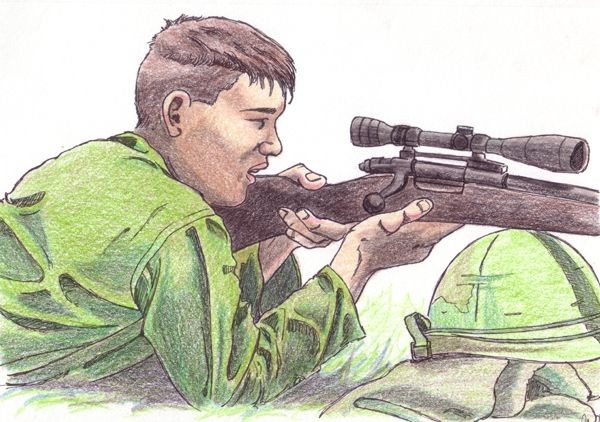
NEW!
GET INVOLVED! DON'T LET AMERICA'S ARMY SELF-DESTRUCT WITH A BAD CHOICE FOR ITS NEXT RIFLE!
Join the 21st Century Rifle Controversy Study Group's Yahoo! message group to get the latest news over the battle for America's next service rifle:

